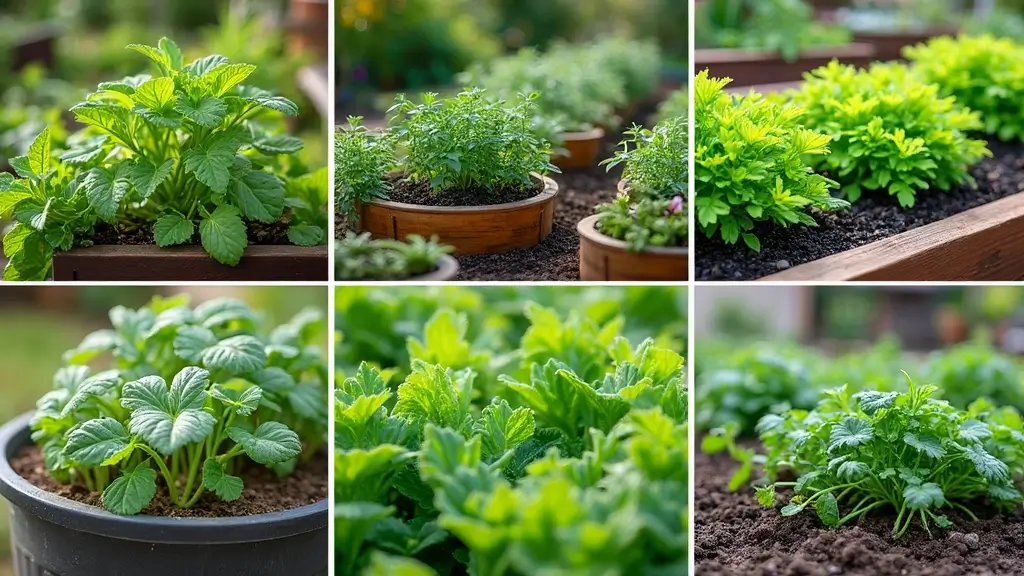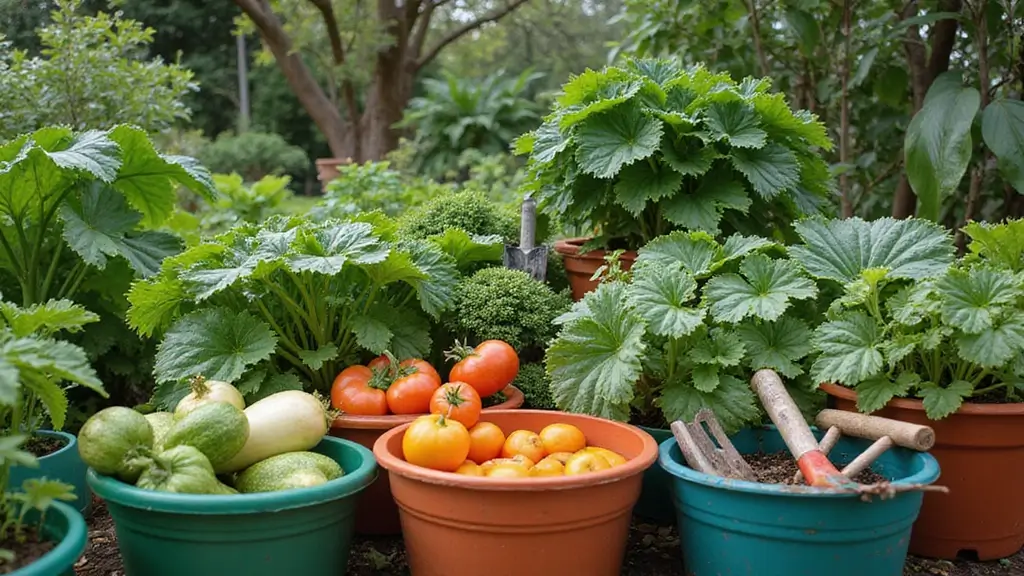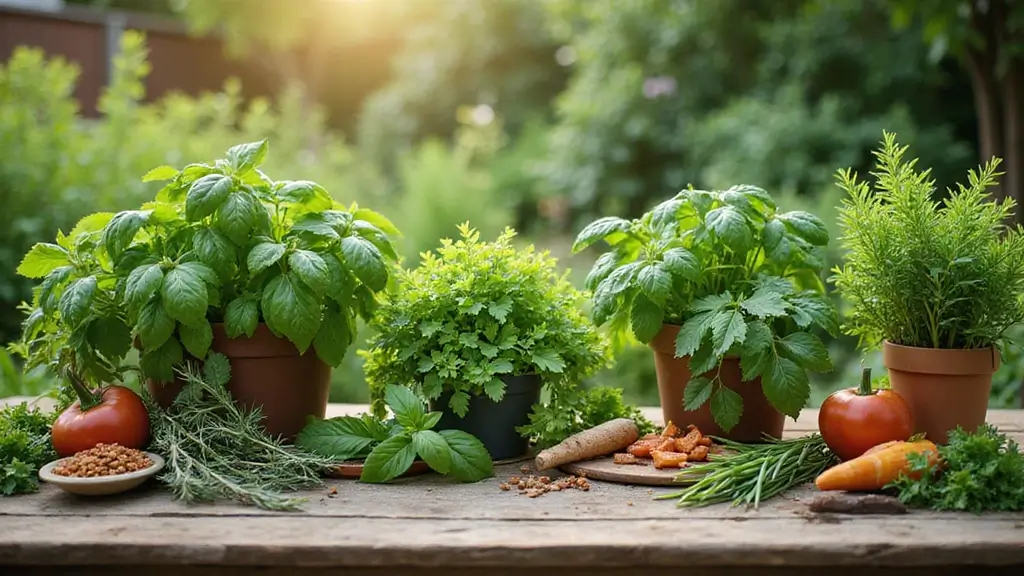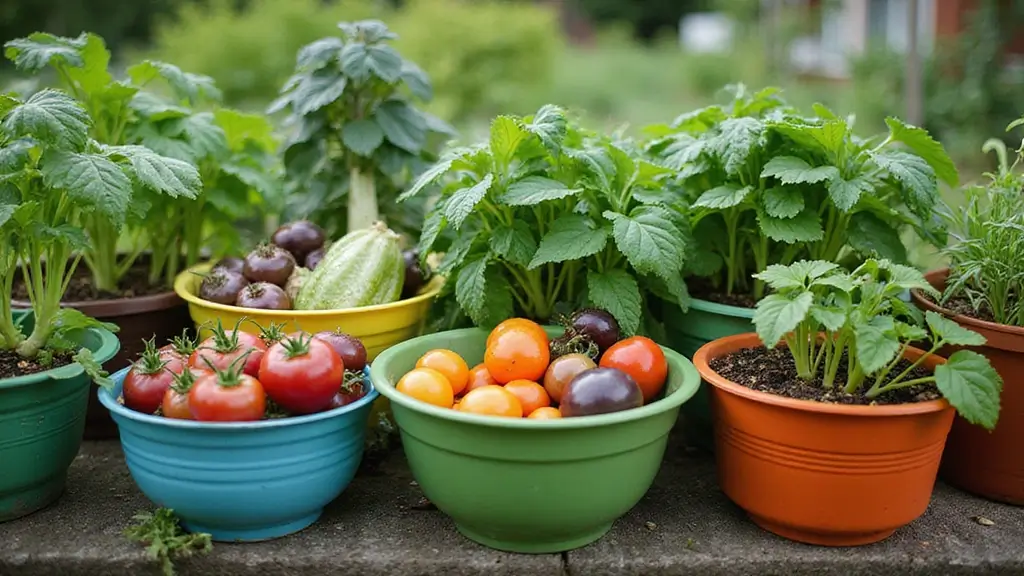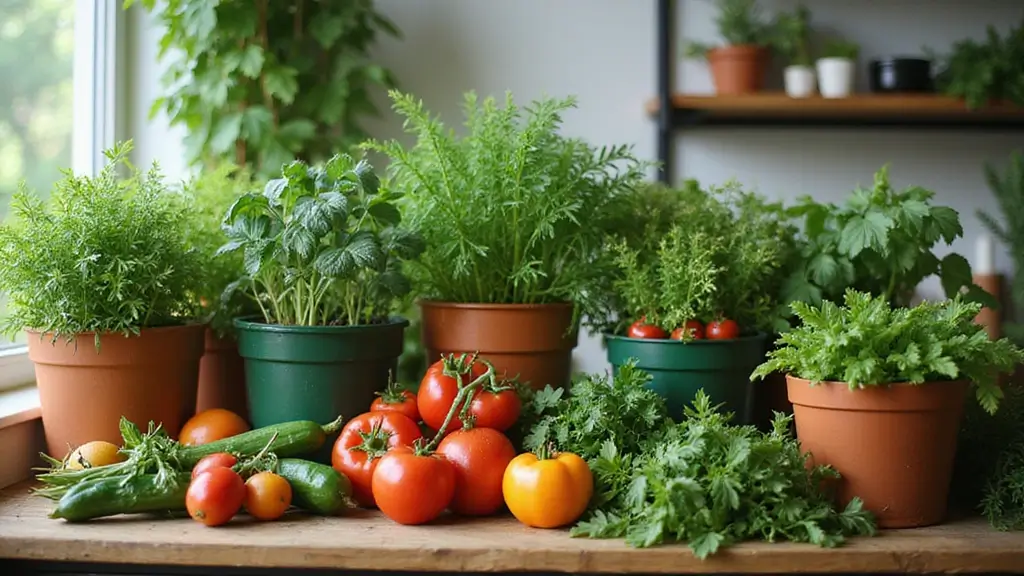Creating a vegetable garden is more than just digging holes and throwing in seeds. It’s about designing a vibrant space that not only yields a bountiful harvest but also delights the senses.
From colorful raised beds to creative container gardens, each unique idea can turn your backyard into a flourishing oasis. With a little creativity and some gardening tips, you can plan your planting schedule to ensure a blooming success throughout the seasons. Let’s jump into 29 vegetable garden design ideas that will inspire your green thumb and transform your space into the ultimate kitchen garden.
1. Raised Bed Gardening
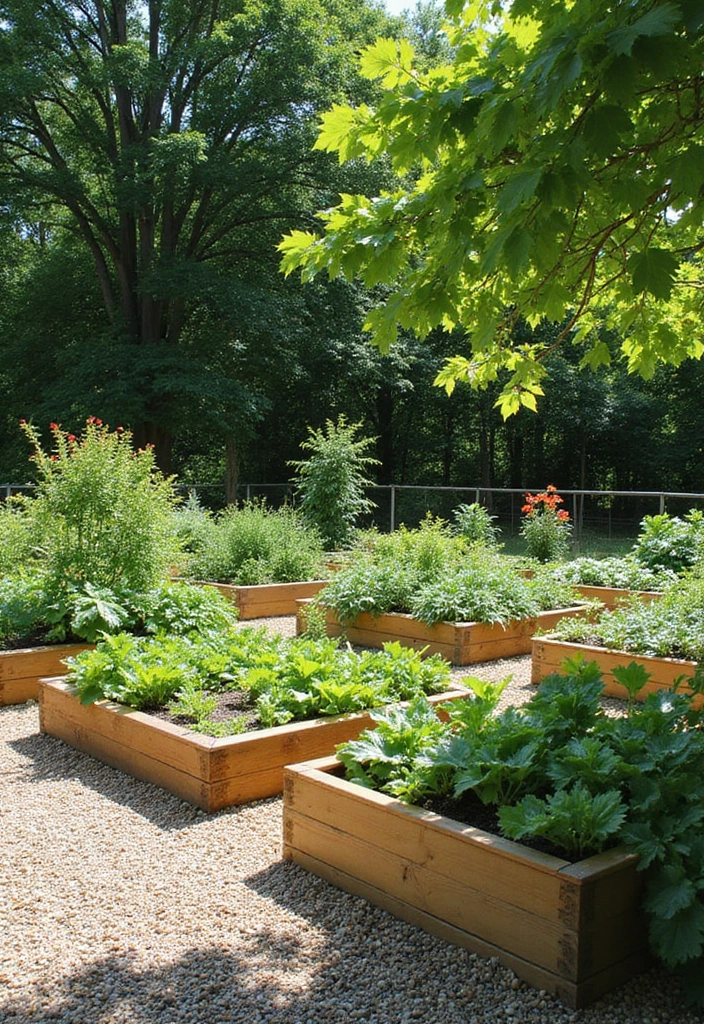
Raised beds are the superheroes of vegetable gardening! They allow for better soil control, improved drainage, and easier access for planting and harvesting. Elevated above ground, these gardens can help slow down soil erosion while offering a designated space for your veggies.
Benefits:
– Increased yield due to better soil quality
– Keeps out pests and weeds effectively
– Ergonomic for easy gardening without bending down too much
When designing your raised bed garden, consider the dimensions carefully. Typically, a width of 4 feet is ideal; this allows you to reach the center without stretching too far. You can also make them as long as you like! For a great start, using raised garden bed kit can simplify the process of building your beds. This galvanized option offers durability and a stylish look for your garden.
Adding a mix of organic compost and soil will provide the nutrients your plants crave. This premium compost promotes healthy growth, ensuring your vegetables thrive. Don’t forget about a good watering schedule – incorporating a drip irrigation kit can help keep everything hydrated efficiently, making it easier to maintain optimal moisture levels for your plants.
To maximize your raised bed:
– Plant taller veggies like tomatoes on the north side to prevent shading shorter plants.
– Mix in companion plants like marigolds to deter pests and attract pollinators.
– Use paths between beds to maintain a neat look while avoiding soil compaction.
Also, painting the wood can add a charming touch to your garden space! It’s a simple way to personalize your garden, making it reflect your style.
2. Vertical Gardening
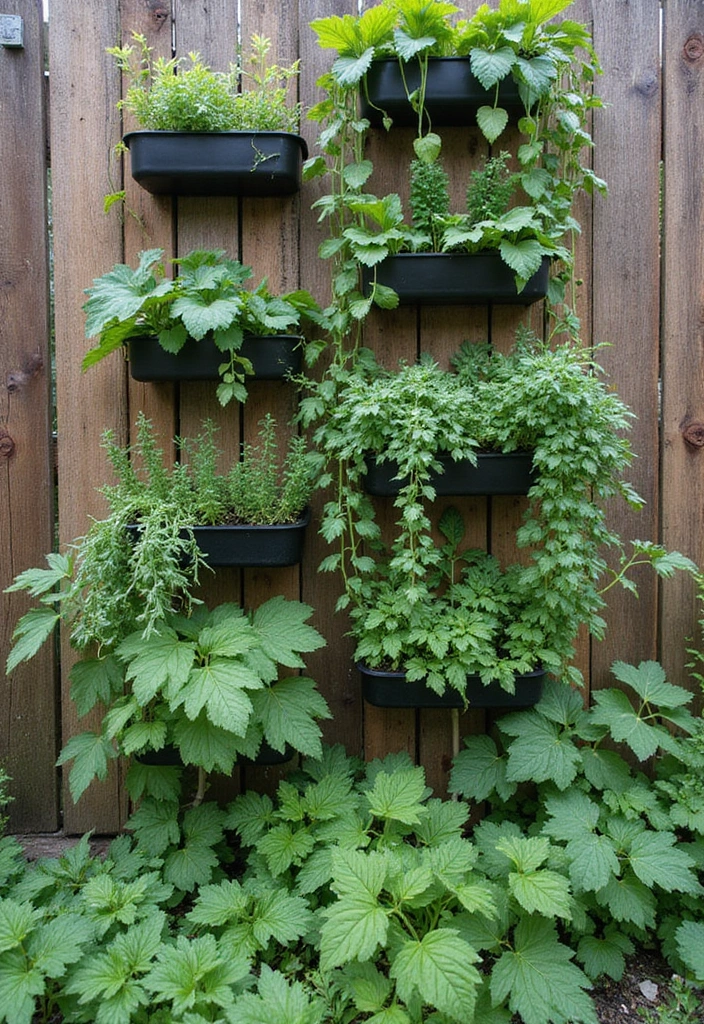
If space is at a premium, vertical gardening can be a game-changer! This design idea allows gardeners to maximize their planting area by growing vertically, using trellises, wall planters, or even vertical garden systems.
Why choose vertical gardening:
– Saves space, making it perfect for urban settings.
– Improves air circulation around plants, reducing disease risk.
– Adds artistic flair to your garden with unique structures.
Consider using Mr. Stacky 5 Tier Stackable Strawberry, Herb, Flower, and Vegetable Planter for smaller veggies or herbs like strawberries and cherry tomatoes. This vertical garden planter is ideal for maximizing your planting area while keeping your garden organized and tidy. Additionally, trellises are essential for climbing plants like cucumbers or peas. The RUBFAC Metal Garden Arch not only utilizes vertical space but also elevates your veggies off the ground, reducing the risk of rot and pests.
Don’t forget to incorporate colorful hanging pots, such as the Set of 2-10 Inch Hanging Planters, perfect for herbs or trailing plants. These self-watering pots help maintain moisture, making it easier to care for your plants while adding a decorative touch.
Remember that sunlight is crucial for vertical gardens, so ensure they’re positioned to get adequate light throughout the day. Pay attention to watering too, as vertical gardens may dry out faster, ensuring you keep a close eye during hot days!
3. Herb Spiral Garden
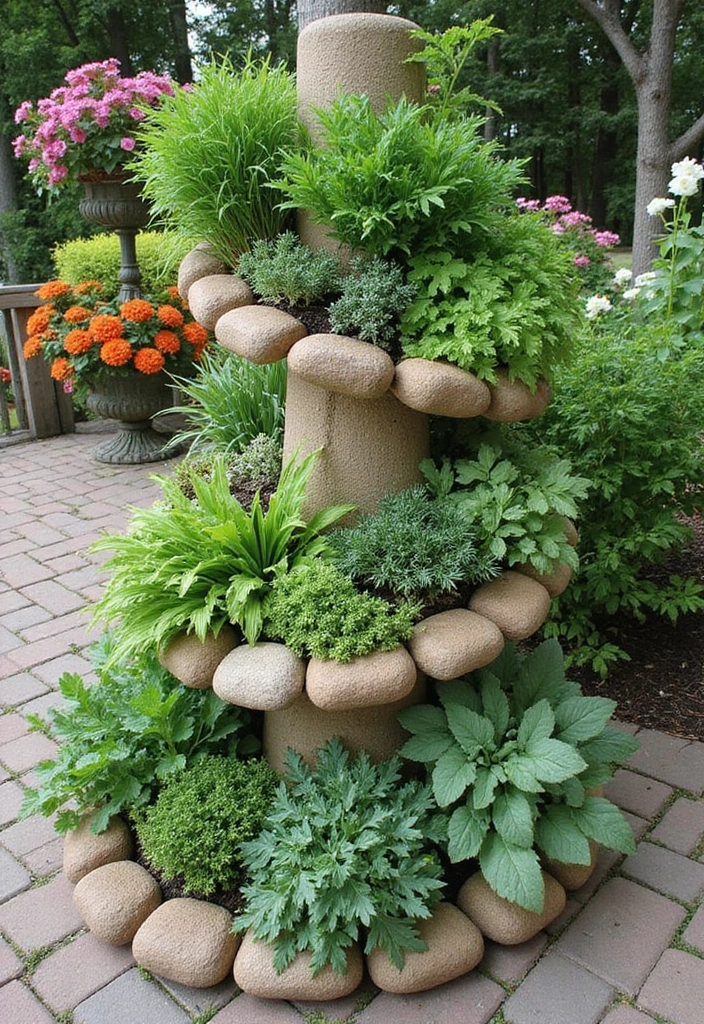
An herb spiral garden is a visually stunning and efficient way to grow herbs! This design creates a spiral shape that allows for a variety of microclimates within a small space, catering to different herb needs.
Advantages of herb spiral:
– Maximizes space while allowing for diverse planting.
– Creates unique microclimates for sun-loving and shade-loving plants to thrive.
– Easy watering, as the top can be watered and gravity pulls it down.
To get started, build a circular or spiral structure using stones or bricks, stacking them higher in the center. Fill the spiral with quality soil, then plant herbs like basil, thyme, and mint according to their light needs – sun at the top, shade-loving at the base. This design not only makes it practical but also incredibly beautiful!
To ensure your herbs thrive, consider using a soil moisture meter. This handy tool allows you to easily monitor the moisture levels in your soil, helping you avoid overwatering or underwatering your plants.
Additionally, enhance your herb garden with an organic herb seeds variety pack. Featuring seeds for popular herbs like basil, cilantro, and thyme, this pack ensures you have a diverse selection for your spiral.
To make the most of your herb spiral, consider companion planting. Pairing herbs can enhance flavors and help keep pests at bay. For even more convenience, you might want to set up a raised garden bed kit to better organize your planting space. Rotate your herbs seasonally, ensuring a continuous supply of fresh flavors for your kitchen.
4. Container Gardening
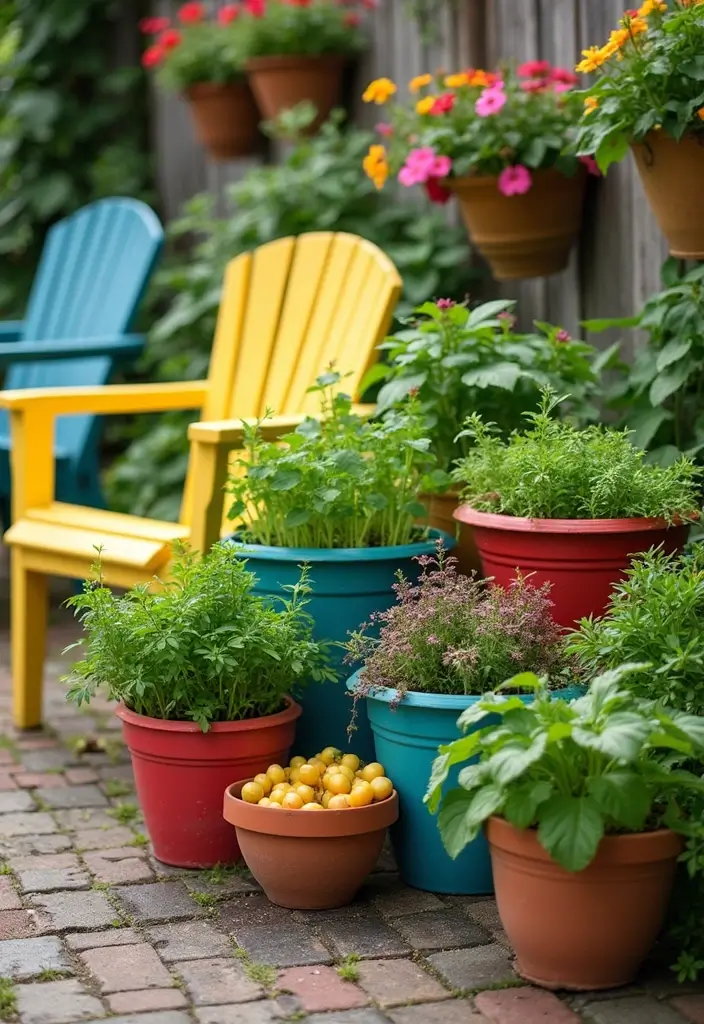
Container gardening is a flexible and stylish way to grow vegetables, making it perfect for patios, balconies, or even small gardens. You can use pots, barrels, or recycled materials; anything goes!
Benefits:
– Ideal for limited spaces or poor soil conditions.
– Easier to control soil quality and moisture levels.
– Allows for creative and beautiful arrangements.
Choose your containers wisely; opt for sizes appropriate for the vegetables you’re planting. Herbs and leafy greens can thrive in smaller pots, while tomatoes and peppers prefer larger ones. For instance, consider using self-watering planters that come in various sizes, providing a deep reservoir that helps maintain moisture levels, reducing the risk of over- or under-watering.
To enhance your container garden, ensure proper drainage by adding rocks or gravel at the bottom. Regularly check the moisture levels, as container plants can dry out more quickly than those in the ground. You can keep your veggies healthy and productive by fertilizing every few weeks with products like organic vegetable fertilizer, which is specifically formulated for nourishing your plants.
Use labels to keep track of what you’ve planted. Items like plant labels for garden are perfect for this, allowing you to organize your garden and add a touch of personality with fun and quirky designs.
Mix different heights and colors to create an eye-catching display, and don’t shy away from using these creative touches to show off your unique style!
5. Kitchen Garden Design
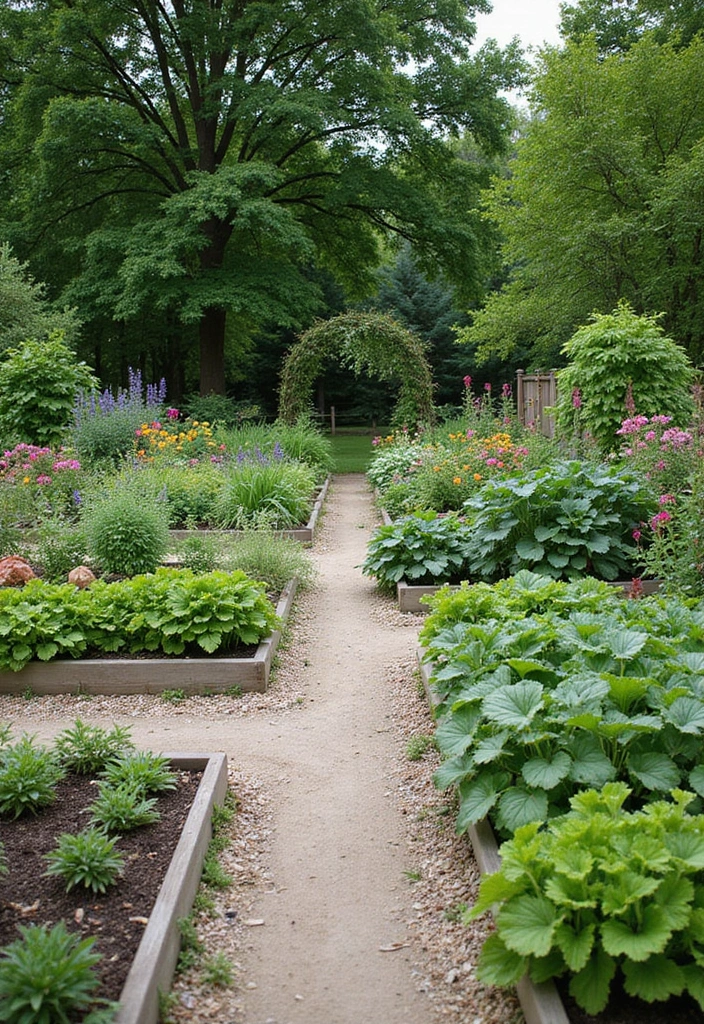
A kitchen garden, or potager, is a French design that seamlessly integrates beauty and function. It features a combination of vegetables, herbs, and flowers, all planted in an organized yet artistic manner.
Key Features:
– Aesthetic appeal through landscaping with flowers and structured planting.
– Easy access to fresh produce right outside your door.
– Encourages biodiversity by combining different types of plants.
Creating a kitchen garden can start with a simple layout, placing your tallest plants like tomatoes at the back and shorter herbs in front. To enhance the gardening experience, consider using tools like a garden tool set, which includes durable hand tools that make planting and maintaining your garden much easier. Mixing in beautiful flowers like nasturtiums or marigolds will help attract beneficial insects.
To create visual interest, think about incorporating curved or zig-zag patterns into your layout. Adding seating areas can transform your gardening space into an inviting retreat. A garden bench would be a perfect addition, providing a cozy spot to relax among your plants.
Don’t forget to set up paths to ensure you can navigate easily through your kitchen garden. If you’re considering raised beds for your vegetables, a raised garden bed kit can offer a stylish and practical solution, allowing you to grow your produce in a structured and accessible way.
By thoughtfully planning your kitchen garden and utilizing these helpful products, you can enhance both its beauty and functionality, turning it into not just a garden, but an outdoor kitchen retreat.
6. Companion Planting
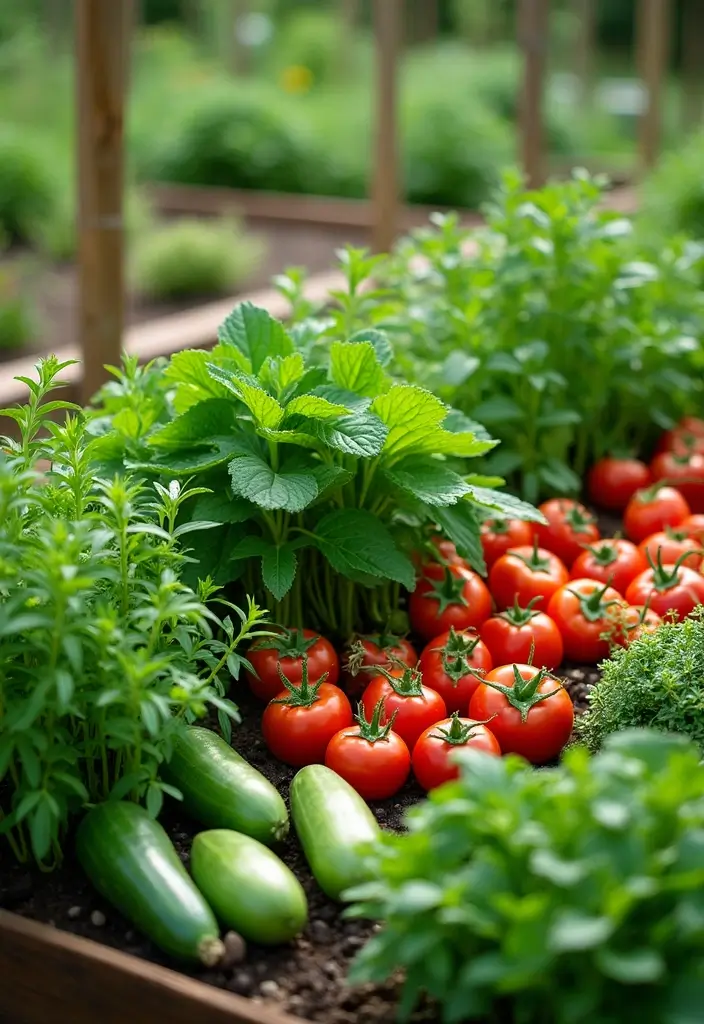
Companion planting is the practice of planting certain plants together to enhance growth and deter pests. This design approach can lead to healthier plants and increased yields all around.
Benefits:
– Natural pest control, reducing the need for chemicals.
– Improved growth rates by pairing compatible plants.
– Enhanced nutritional profiles in the garden.
For example, planting carrots and onions together can help mask the scent of carrots, deterring pests. Tomatoes and basil are famous companions, with basil enhancing the flavor of the tomatoes while warding off pests. To further aid in pest management, consider using Mighty Mint Gallon Insect and Pest Repellent, a natural spray that effectively repels spiders, ants, and other unwanted pests, making your companion planting efforts even more successful.
A quick guide can help you remember which plants thrive together. To get started, you might want to check out the companion planting guide poster, which visually outlines compatible plant pairings and can serve as a handy reference while planning your garden.
Plan your garden layout based on these companions, grouping plants that benefit each other. A diverse garden not only looks beautiful but also creates a balanced ecosystem. Regularly observing your plants can help you adjust pairings as needed, getting the most out of your garden.
7. Square Foot Gardening
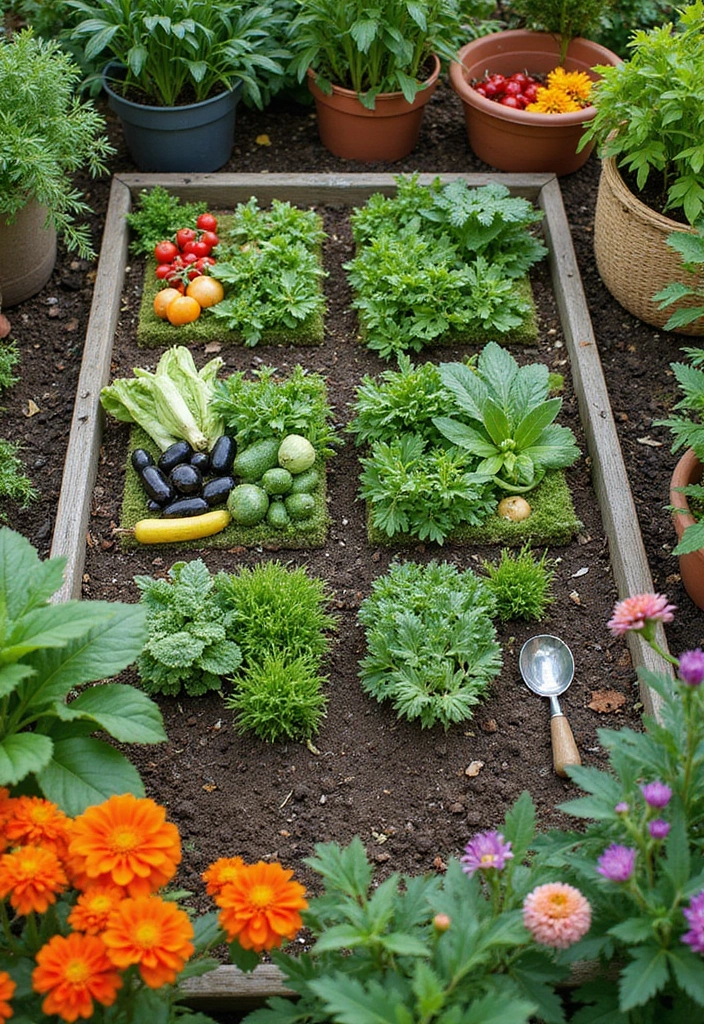
Square foot gardening is a clever method that divides a garden into small squares, making planning and planting easy. This design maximizes space while simplifying the gardening process.
Why It Works:
– Optimizes space efficiency with defined planting areas.
– Reduces weeding and watering efforts.
– Increases yield in a small area.
To create your square foot garden, define a grid using wooden slats or strings. A great solution for this is the square foot gardening grid kit, which simplifies the setup and ensures that every plant gets the right amount of water, thanks to its built-in drip irrigation system. Each square, typically 1×1 foot, hosts a different plant, with the number of plants varying according to their size. For example, you can fit 16 radishes in one square but only one tomato plant.
Maintaining a planting schedule and rotating your crops seasonally will help keep the soil healthy and vibrant. For mobility and convenience, consider using an elevate raised garden bed planter, which features wheels and a shelf for easy access. This sturdy planter can support up to 400 lbs, making it perfect for a variety of vegetables and herbs.
In addition, having the right tools makes a significant difference in your gardening experience. A gardening tool set with heavy-duty hand tools and a stylish organizer handbag will ensure that you’re equipped to tackle any task, from planting to maintenance. Interspersing flowers can also attract pollinators and add beauty to your garden.
8. Pollinator Gardens

Creating a pollinator garden is an exciting way to attract bees, butterflies, and other beneficial insects to your vegetable garden. These gardens can enhance pollination, leading to a more bountiful harvest and a healthy ecosystem.
Features:
– Variety of plants that bloom at different times for year-round nourishment.
– Encourages biodiversity in your garden.
– Typically requires less maintenance once established.
Start by choosing native flowering plants that attract local pollinators. A great option is the California wildflower mixture, which contains over 7,000 native seeds that are open pollinated and non-GMO. Adding flowers like lavender, sunflowers, and coneflowers not only beautifies your garden but also provides essential resources for these creatures.
Ensure there’s a water source nearby, as it’s vital for pollinators. A useful addition is the bee watering station, which serves as a floating bee island, providing a safe place for bees to hydrate while you create a welcoming environment for them.
Incorporating native plants and avoiding harmful chemicals is crucial. For those times when natural pest control is needed, consider using Bonide Captain Jack’s Neem Oil, an organic pesticide alternative that acts as a multi-purpose fungicide and insecticide for your garden. The more diverse your garden, the better it supports the local ecosystem, inviting a colorful array of butterflies and bees to your veggie patch.
9. Edible Landscaping
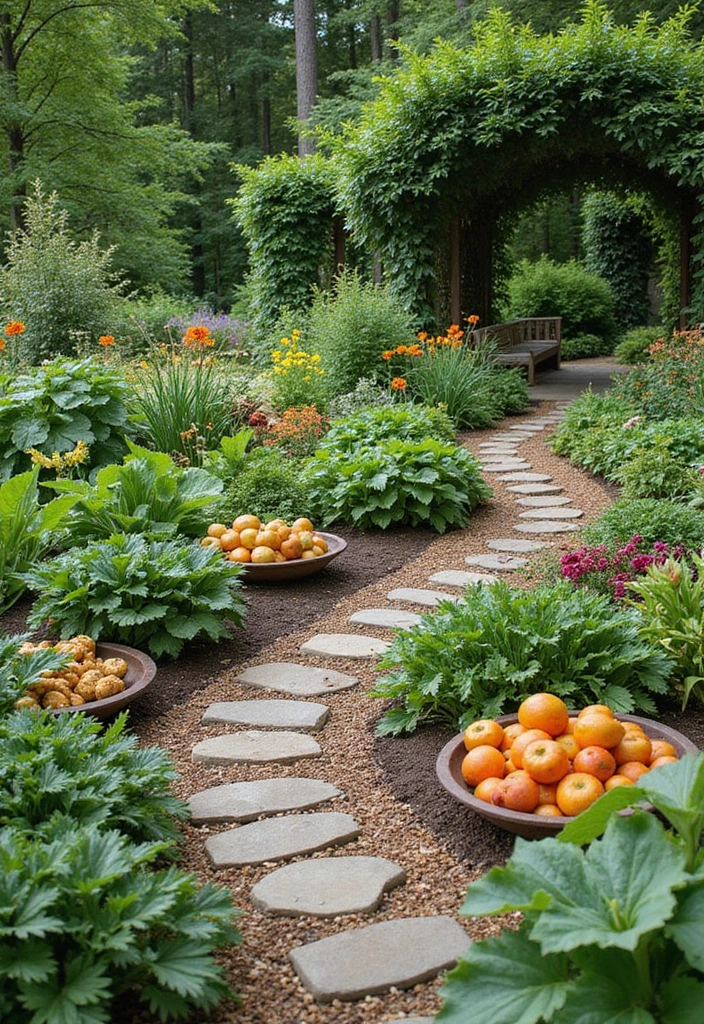
Edible landscaping combines aesthetics with practicality by integrating edible plants into your landscape design. This approach not only beautifies your outdoor space but also provides fresh produce right from your yard.
Benefits:
– Visually appealing garden that serves a purpose.
– Lowers grocery bills by growing your food.
– Fosters a connection with nature and sustainable practices.
Consider incorporating fruit trees, berry bushes, and ornamental vegetables while designing your landscape beds. Use colorful plants like kale and rainbow chard to create visual interest. To set the stage for your edible landscape, a raised garden bed kit can be a great addition. These galvanized raised garden beds are perfect for cultivating herbs and vegetables, making gardening easier and more organized.
Planting edibles in ornamental beds creates a seamless look while adding functionality. Adding garden pathway stones can enhance the beauty of your space while providing a durable and attractive pathway. This makes it convenient to navigate through your lush garden while enjoying the scenery.
Incorporating seating areas and garden decorations will make the edible landscape inviting and enjoyable. To further promote sustainability, consider using a compost bin for your kitchen scraps. This not only helps reduce waste but also provides rich compost for your garden, creating a productive haven right in your yard.
Embrace the beauty and utility of edible landscaping and watch your outdoor space flourish!
10. Shade Gardening
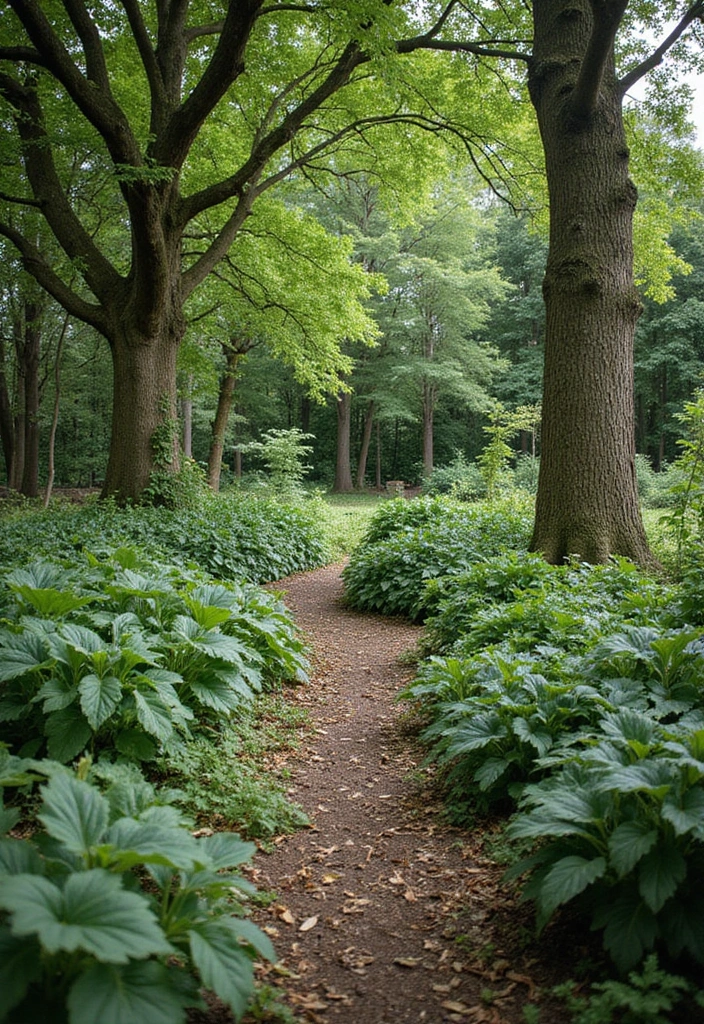
For those with shady backyards, shade gardening is the perfect solution! Less sunlight doesn’t mean you can’t enjoy a productive garden; it just requires choosing the right plants and careful planning.
Advantages:
– Expands gardening possibilities in shaded areas.
– Allows for unique plant combinations that thrive in low light.
– Conserves water and reduces weed growth.
Start by identifying the shady areas of your yard and selecting shade-tolerant vegetables like leafy greens, radishes, and some herbs. You can kickstart your garden with the shade tolerant vegetable seeds, which include a variety of non-GMO heirloom seeds perfect for autumn and indoor gardening. Many perennials can also thrive, adding beauty and texture to your garden.
Consider layering your plants, placing taller ones where they can catch the most light while keeping shorter ones below. Adequate soil preparation is crucial, and using a high-quality mix like soil preparation mix from Burpee will help nourish your shade garden effectively.
Regular watering is essential, and a little mulch goes a long way in maintaining moisture. The organic mulch from Back to the Roots is an excellent choice, as it not only retains moisture but also adds valuable nutrients to your soil. With these thoughtful selections, you can create a lush, productive shade garden that thrives even in low light conditions.
11. Dynamic Color Schemes
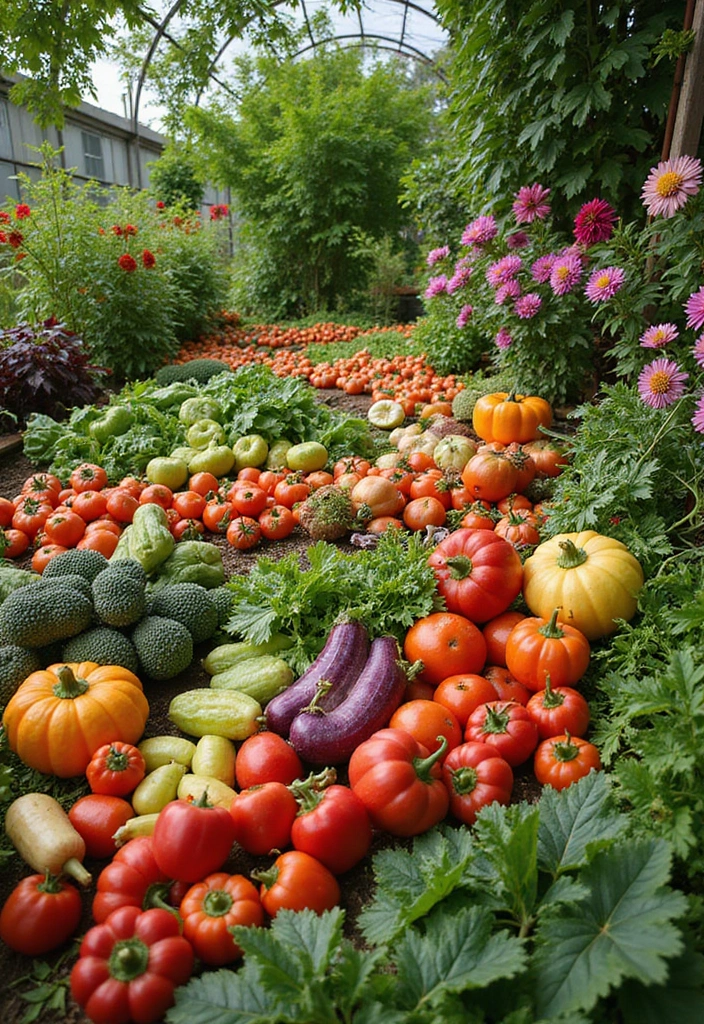
Incorporating dynamic color schemes into your vegetable garden can make your outdoor space pop! Color not only enhances the beauty but can also indicate plant health and ripeness.
Why color matters:
– Helps identify ripe fruits easily.
– Enhances visual appeal and enjoyment.
– Can indicate plant health, like yellowing leaves in distress.
When planting, aim for a diverse palette. Brightly colored vegetables like purple eggplants, yellow squash, and red tomatoes can create a stunning contrast against lush green leaves. You might consider using the colorful vegetable seeds variety pack, which includes vibrant options like Romanesco and watermelon radish, to introduce unique colors to your garden.
Intermixing colorful flowers like zinnias or cosmos can add even more vibrance to the garden. To help you design a visually striking layout, a garden color wheel can assist you in creating exciting color combinations. This tool is perfect for arranging plants in gradients or distinct color zones. This colorscape will not only be visually appealing but will also inspire others to adopt vibrant designs in their gardens.
12. Fruit Tree Integration
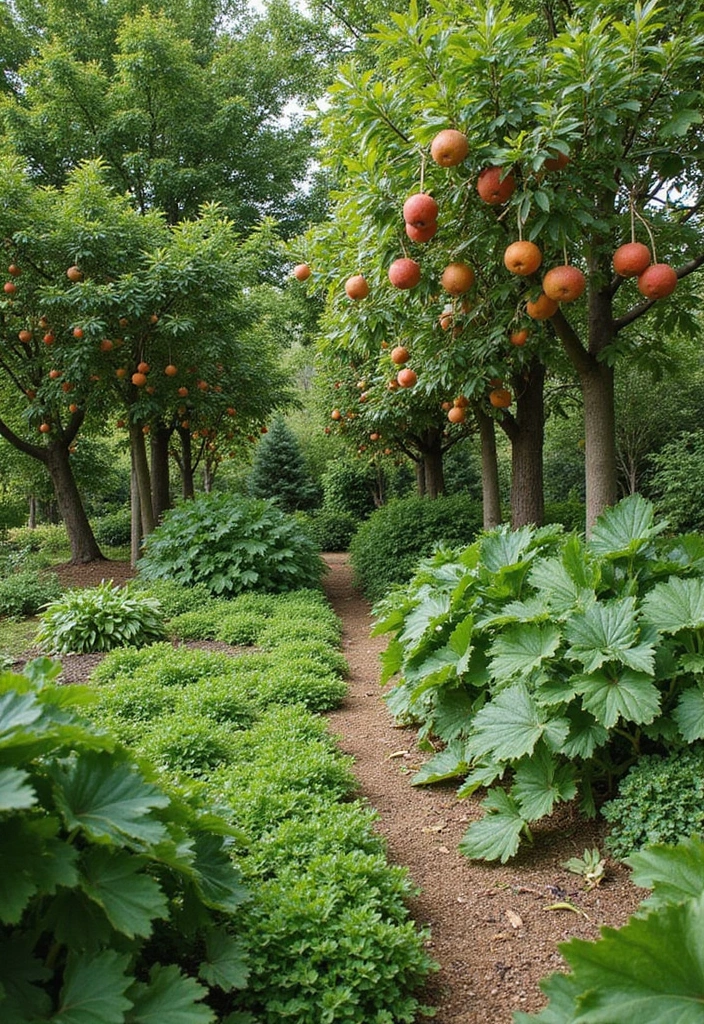
Integrating fruit trees into your vegetable garden can create a multi-tiered landscape that maximizes space and offers delicious harvests. The combination of trees and vegetables can create a lush, fruitful area.
Benefits:
– Provides shade for smaller plants, reducing heat stress.
– Generates a diverse ecosystem within your garden.
– Yields multiple harvests from one space.
Start by choosing dwarf or semi-dwarf fruit trees that fit well within your garden space. For instance, consider the Golden Delicious apple tree, which is a perfect option for smaller gardens. Pair these trees with ground-covering plants or shade-loving veggies for a layered look. For example, you could plant strawberries or squashes under apple or peach trees to utilize the space beneath them effectively.
To keep your fruit trees healthy and productive, regular pruning is essential. This is where a reliable pair of pruning shears comes in handy. With a 5/8-inch cut capacity and a sharp, rust-resistant steel blade, these shears will make maintaining your trees easier, allowing you to enjoy consistent harvests.
Additionally, consider planting companion plants that attract beneficial insects and provide organic pest control. The Lush&Dew full companion plants seed bank offers 32 varieties of non-GMO heirloom seeds perfect for this purpose. By integrating these plants, you will further enhance the biodiversity of your garden, promoting a healthy environment for both your fruit trees and vegetables.
13. Wildlife-Friendly Designs
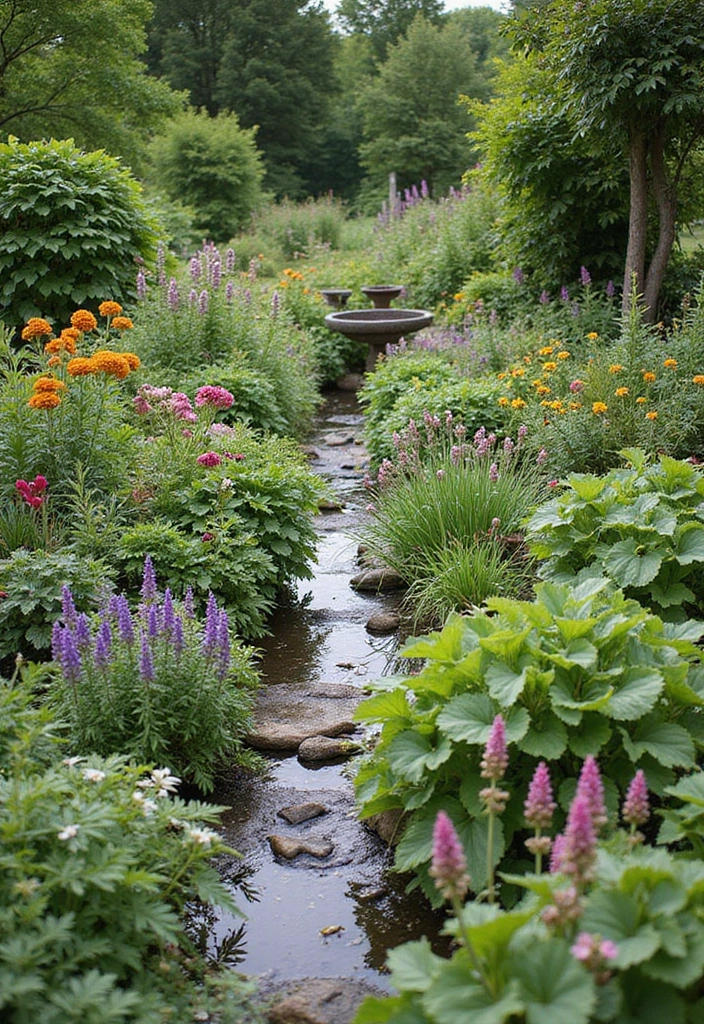
Creating a wildlife-friendly vegetable garden is a wonderful way to support local ecosystems while enjoying nature’s beauty. This approach focuses on attracting beneficial animals, like birds and butterflies, which can help pollinate and control pests in your garden.
Key Features:
– Diverse plant species to attract various wildlife.
– Natural habitats for beneficial insects and birds.
– Increased biodiversity and resilience.
Incorporate native plants, wildflowers, and shrubs that provide food and shelter for local wildlife. A great addition to your garden is a native wildflower seed mix, which includes 18 varieties of non-GMO flower seeds that will not only beautify your space but also draw in pollinators. Adding features like a birdbath for garden can encourage birds to visit your garden, providing them with a source of water and a charming accent to your landscape. Additionally, consider creating a compost heap using a compost bin that can attract beneficial insects to help break down organic matter, enriching your soil.
Use organic gardening methods to maintain a healthy ecosystem, avoiding harmful pesticides. This design not only beautifies your garden but fosters a natural balance that benefits all plants and animals.
Invite nature into your veggie garden! By creating a wildlife-friendly design, you’ll not only attract beautiful birds and butterflies but also boost your garden’s health and biodiversity. Plant native species and watch your garden thrive!
14. Fragrant Garden Designs
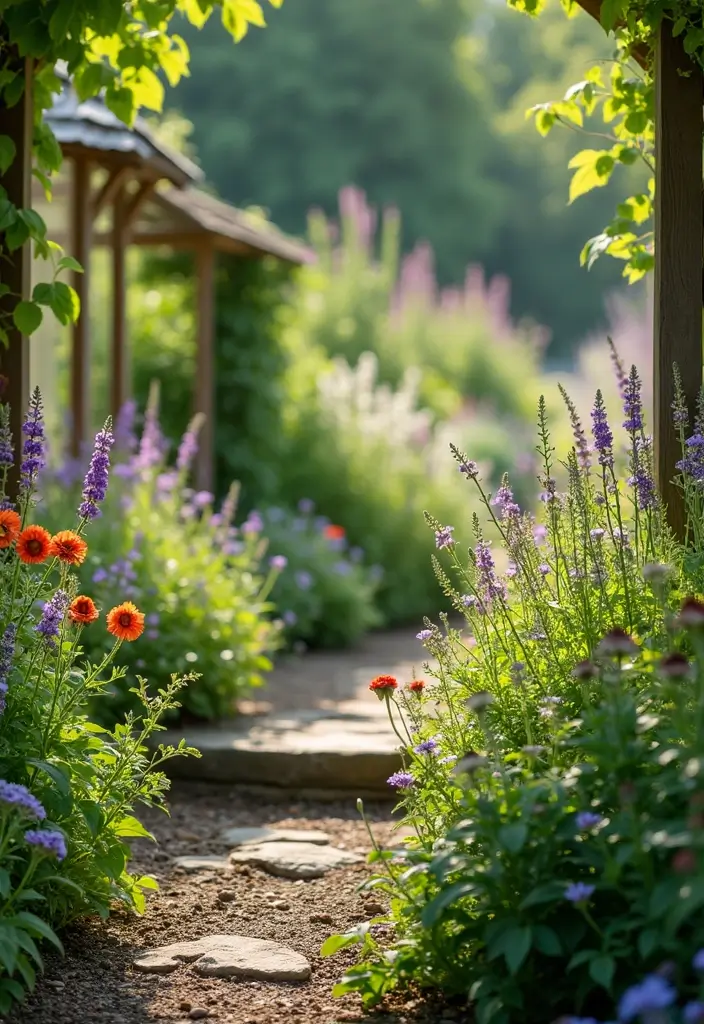
A fragrant vegetable garden is a sensory delight and can enhance your gardening experience. Incorporating aromatic herbs and flowers can create a wonderful atmosphere while attracting beneficial pollinators.
Benefits of aromatic plants:
– Enhances the gardening experience with pleasant scents.
– Attracts pollinators while repelling pests.
– Supports a diverse ecosystem.
Start by selecting herbs like rosemary, thyme, and lavender, which not only smell great but also provide culinary benefits. For beginners, consider using an herb garden starter kit that includes a variety of kitchen herbs, making it easy to grow your own aromatic plants right on your windowsill or countertop. Pair them with beautiful flowering plants like marigolds or petunias to create a sensory explosion in your garden.
To enhance the experience further, think about creating a designated ‘fragrant corner’ in your garden where you can sit and enjoy the scents and sights. Installing pathways leading to this area will also enhance accessibility. The garden pathway edging stones can help define the space beautifully while adding a decorative touch to your garden layout.
Additionally, consider incorporating plants like lilacs to boost the fragrance. You can start with fragrant flower seeds assortment, which includes non-GMO, heirloom tree seeds ideal for landscaping and attracting pollinators. These selections will not only enhance the scent in your garden but also support a thriving ecosystem.
With these tips and products, you can create an aromatic vegetable garden that delights the senses and invites nature to flourish around you.
15. Seasonal Planting Schedules
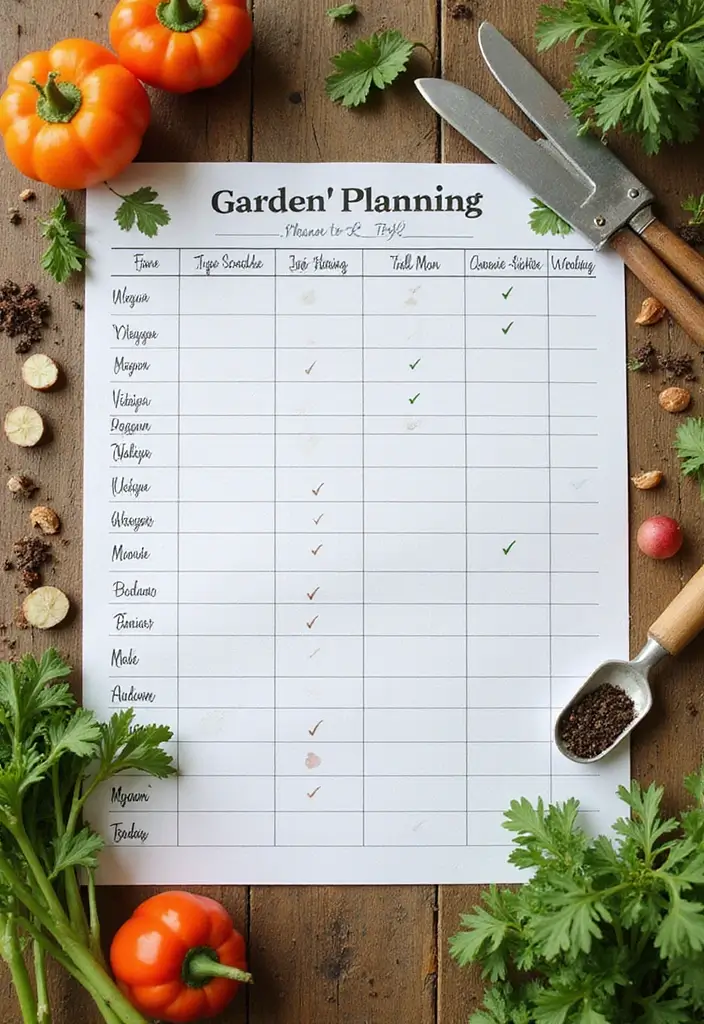
Understanding seasonal planting schedules is crucial for a successful vegetable garden. Knowing when to plant different vegetables ensures a staggered harvest and maximizes your production throughout the year.
Why It Matters:
– Avoids planting mishaps and ensures healthy plants.
– Provides a steady supply of fresh produce.
– Maximizes your gardening efforts.
To help you create a planting calendar based on your region’s climate and frost dates, consider using a garden planner software. This tool allows you to track your gardening successes and learn from past mistakes, ensuring that you’re well-prepared each season. Cool-season vegetables such as peas and lettuce can thrive in early spring, while warm-season crops like tomatoes and peppers prefer the heat of summer. Planning ahead means you can rotate crops effectively, maintaining soil health and productivity.
Additionally, a planting calendar can guide you in gardening in tune with the phases of the moon, helping you find the best times to sow, plant, prune, and harvest. This knowledge can be particularly beneficial for both beginner and seasoned gardeners.
Consider succession planting as well, where you periodically sow seeds of the same crop to prolong your harvest. For this, the succession planting seed pack offers a collection of spinach seeds with growing instructions, perfect for ensuring you have fresh veggies throughout the growing season without overwhelming yourself with more produce than you can handle at once.
Plan your garden like a chef prepares a recipe: timing is everything! A well-timed planting schedule guarantees a fresh and bountiful harvest all year long.
16. Coastal Garden Designs
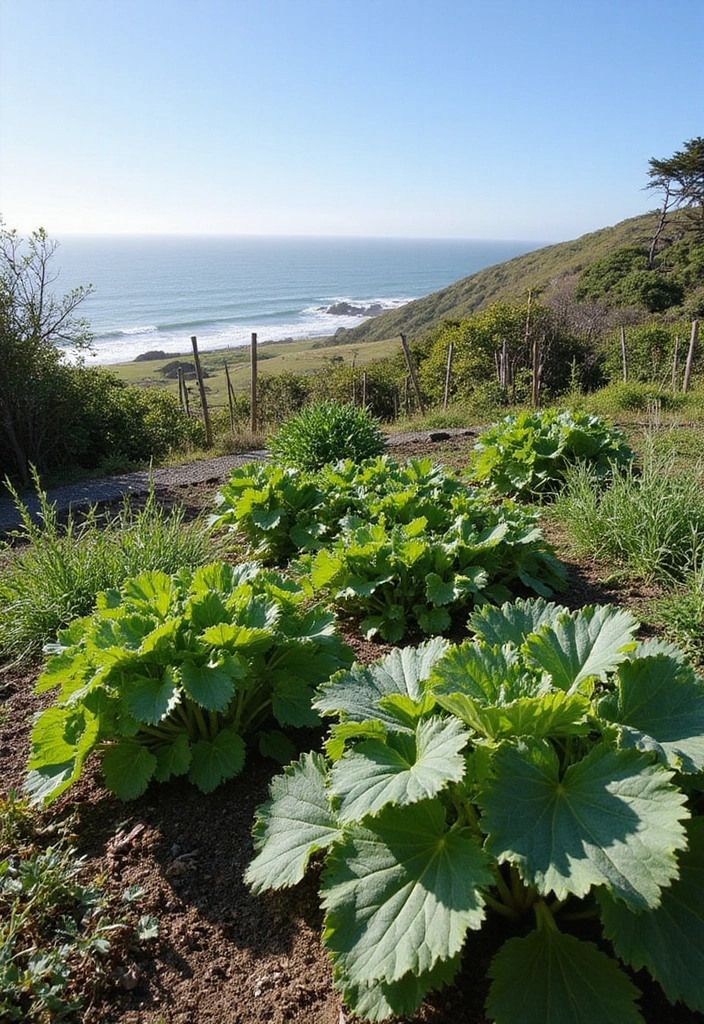
If you live near the coast, designing a vegetable garden with salt-tolerant plants can create a unique and beautiful space. Coastal gardens often present challenges like wind, salt spray, and sandy soil, but with the right design, they can thrive.
Key Features:
– Selection of salt-tolerant vegetable varieties.
– Windbreaks to protect delicate plants.
– Creative use of local materials for structure.
Consider planting vegetables such as kale, spinach, and certain herbs that can withstand salty conditions. For your seeds, check out the salt-tolerant vegetable seeds, which include a variety of drought-resistant plants perfect for coastal conditions.
Building windbreaks using native shrubs or trees can help shield your garden from harsh coastal winds while adding privacy. For a great option, consider the Garden Windbreaks (Native Shrubs or Trees) such as Podocarpus macrophyllus, which can serve as an effective barrier against the wind.
Additionally, creating raised beds will improve soil conditions and retain moisture, making them an ideal solution for sandy coastal soils. The Raised Garden Bed Kit is an excellent choice for constructing these beds, providing you with a sturdy and accessible planting space.
Incorporating native coastal plants into your garden design can enhance the aesthetic while supporting the local ecosystem. By creating a diverse landscape, you can look forward to a vibrant garden full of life!
17. Urban Garden Oasis
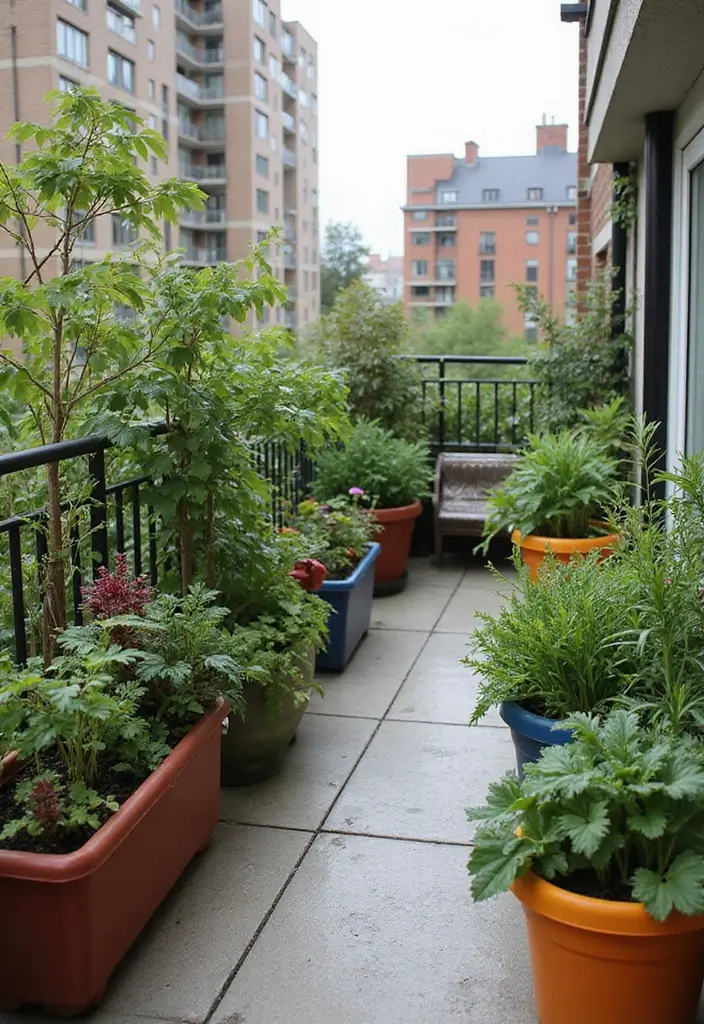
Transforming a small urban space into a thriving vegetable garden is all about creativity and resourcefulness. Even the tiniest balcony or rooftop can become an oasis of greenery.
Maximizing vertical space is key, and using products like PlantPod Luxe – self-watering wall planters can help you design your own vertical garden effortlessly. These lightweight planters are easy to install and maintain, making them perfect for small spaces. You can also consider Mr. Stacky 5 tier stackable planters for growing strawberries, herbs, flowers, and vegetables. These stackable planters not only save space but also allow for a diverse mix of plants.
Container gardening works wonders too, allowing you to combine various vegetable varieties in stylish planters that suit your space. To enhance the ambiance of your urban garden, think about adding solar-powered garden lights. These decorative lights create a warm, inviting atmosphere while being environmentally friendly.
Engaging your community through shared urban gardens can foster a sense of connection and encourage collective gardening efforts. Urban gardening creates sustainable solutions for fresh produce while beautifying your surroundings.
18. Sustainable Gardening Practices
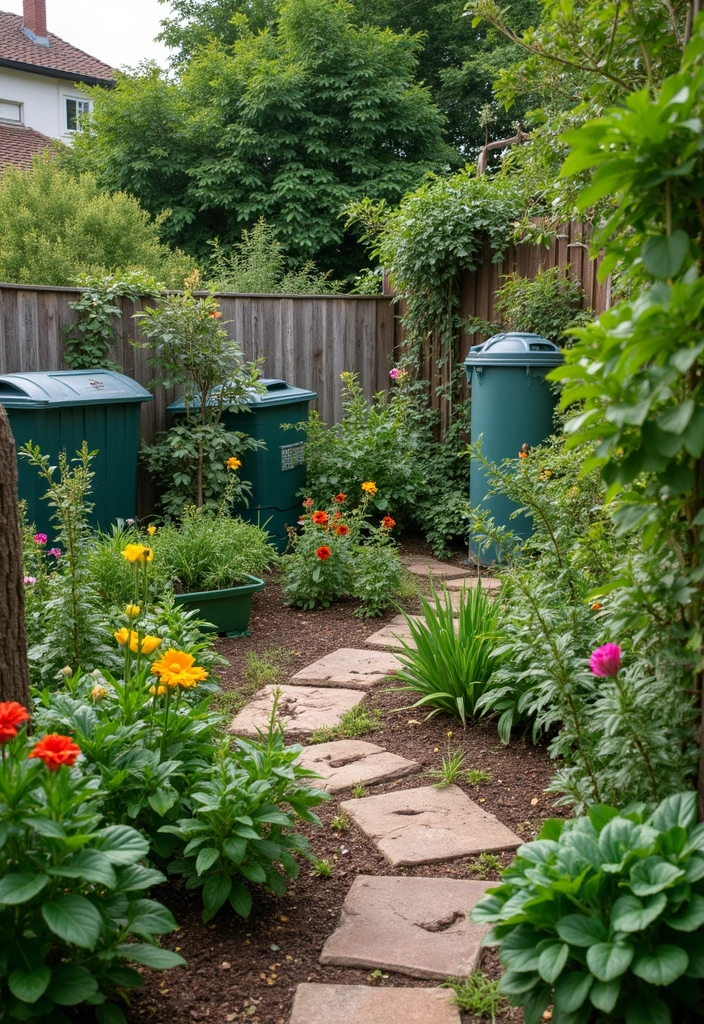
Sustainable gardening practices are essential for maintaining healthy ecosystems while providing food. Integrating organic methods and eco-friendly designs can have a lasting positive impact on the environment.
Benefits:
– Reduces chemical use, promoting biodiversity.
– Saves water through efficient practices.
– Enhances soil health and productivity.
Consider implementing methods like composting with a Compost Bin, which makes it easy to recycle kitchen waste and produce nutrient-rich compost that can improve your soil’s health. A well-managed compost bin not only benefits your garden but also reduces landfill waste.
Another effective practice is rainwater harvesting. Using a Rainwater Harvesting System allows you to collect and store rainwater, conserving valuable water resources and utilizing natural rainfall to nourish your plants. This efficient method helps you maintain a sustainable garden even during drier months.
In addition, building habitats for beneficial insects, such as installing a bee hotel, can enhance your garden’s ecological footprint. A Bee Hotel provides a safe environment for pollinators, which is crucial for the health of your plants and the overall ecosystem.
Sustainable gardening not only yields a healthy harvest but also contributes positively to the planet. By embracing these eco-friendly practices, we can grow vibrant veggies while enhancing our soil and conserving water for generations to come.
Sustainable gardening isn’t just a trend; it’s a lasting way to nourish our planet. By embracing eco-friendly practices, we can grow vibrant veggies while enhancing our soil and conserving water for generations to come!
19. Minimalist Garden Design
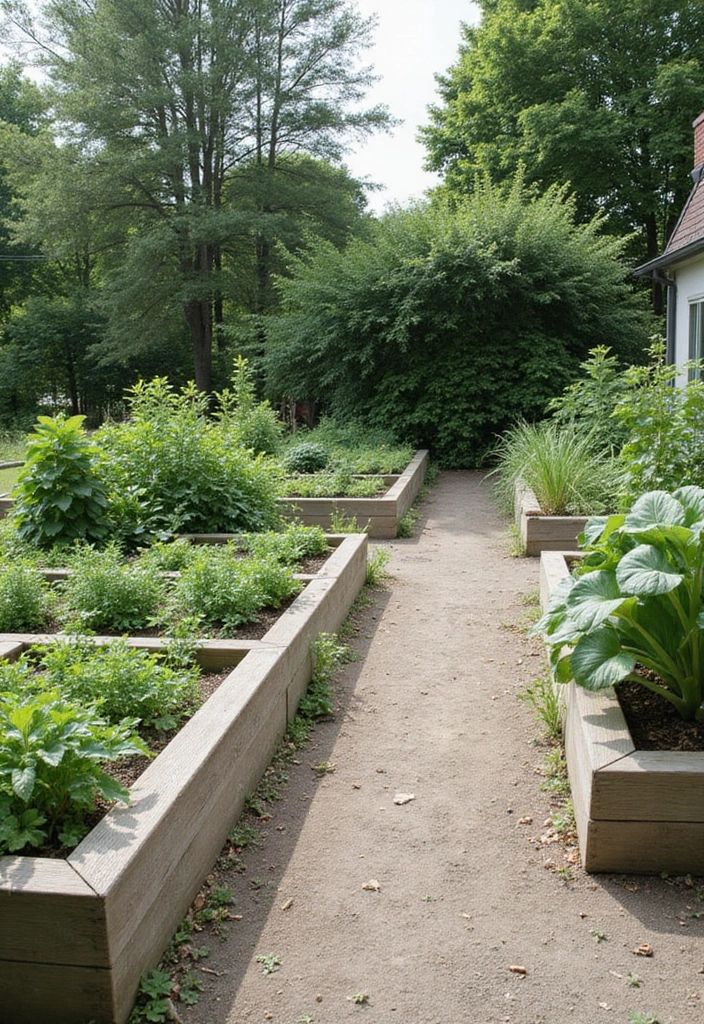
A minimalist vegetable garden design focuses on simplicity and functionality, helping create a serene yet productive space. This approach allows gardeners to concentrate on fewer plants while maximizing yields and minimizing clutter.
Key Features:
– Clean lines and organized layouts.
– Fewer plant varieties for easier maintenance.
– A focus on high-yielding crops.
Choose a limited number of crops that you love to eat and plan your layout carefully. Incorporating a raised garden bed kit can provide clean edges and defined spaces, which are essential for a minimalist design. The mobility of this raised bed, equipped with wheels, makes it easy to rearrange as needed while also allowing for a 400lbs capacity, ensuring you can grow a variety of vegetables or herbs without the hassle.
To enhance the simplicity of your garden, consider using garden pathway stones. These polished pebble stones can create smooth, organized walkways that add to the clean aesthetic of your garden while making maintenance much easier. Their multi-color options can complement the minimalist theme without adding unnecessary complexity.
Regular maintenance and observation are key to keeping weeds at bay, supporting a low-maintenance lifestyle. A good set of tools can make all the difference, which is where a gardening tool set comes in handy. With a 9-piece heavy-duty collection, you’ll have everything you need to keep your minimalist garden thriving.
This design not only provides food but also transforms into a peaceful retreat in your home, making your gardening experience enjoyable and fulfilling.
20. Community Gardens
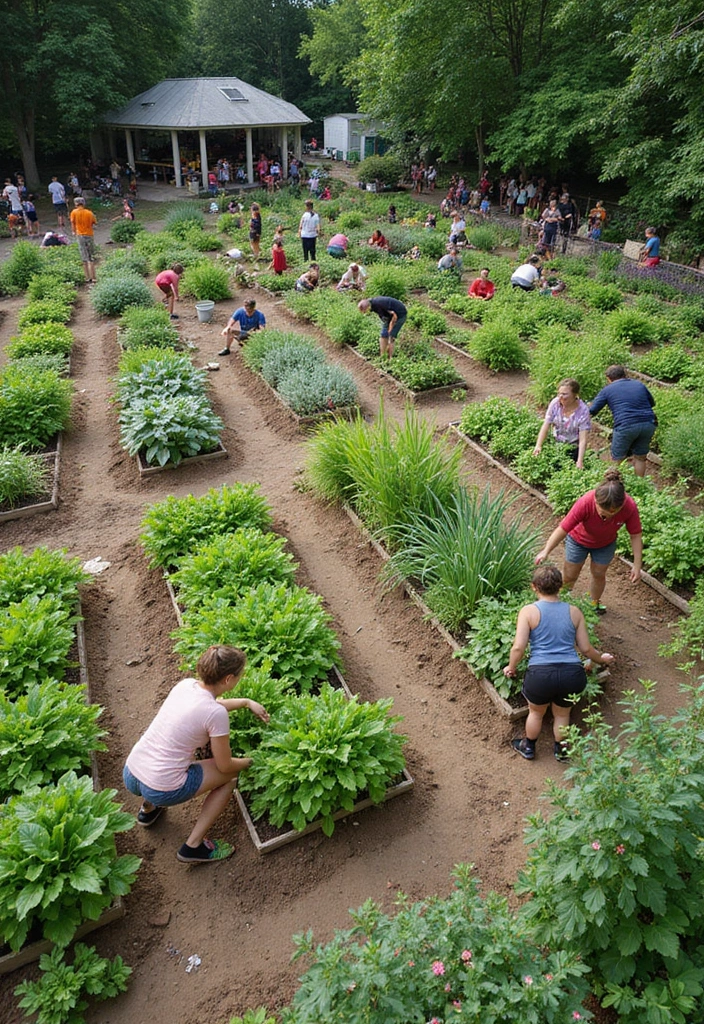
Community gardens are a fantastic way to bring people together while growing fresh food. These shared spaces foster collaboration and creativity, allowing individuals to connect over gardening while producing delicious veggies.
Benefits:
– Builds community relationships and social connections.
– Provides fresh produce to communities with limited access.
– Encourages sharing knowledge and skills.
Consider creating or joining a local community garden where members can contribute their skills and efforts. Each gardener can have their plot or work together on communal areas, growing a diverse selection of vegetables and flowers. Regular meetings to discuss gardening strategies can also lead to friendships and support networks.
To enhance your gardening experience, having the right tools is essential. A gardening tools 9-piece heavy duty gardening hand tools with fashion and durable garden tools organizer handbag can make all the difference, providing everything you need to cultivate your plants effectively.
For those looking to optimize space and ensure healthy growth, consider using a raised garden bed kit. It allows you to create structured planting areas that can help manage soil quality and drainage, making it easier to grow a variety of vegetables.
Don’t forget about composting! A compost bin for kitchen countertop is a great addition to any community gardener’s toolkit. It helps you recycle kitchen scraps, turning waste into nutrient-rich compost for your garden.
Community gardens not only cultivate fresh produce but also nurture relationships and a shared sense of purpose among participants. With the right products, you can enhance your gardening efforts and enjoy a more fruitful harvest together.
21. Rustic Farmhouse Style
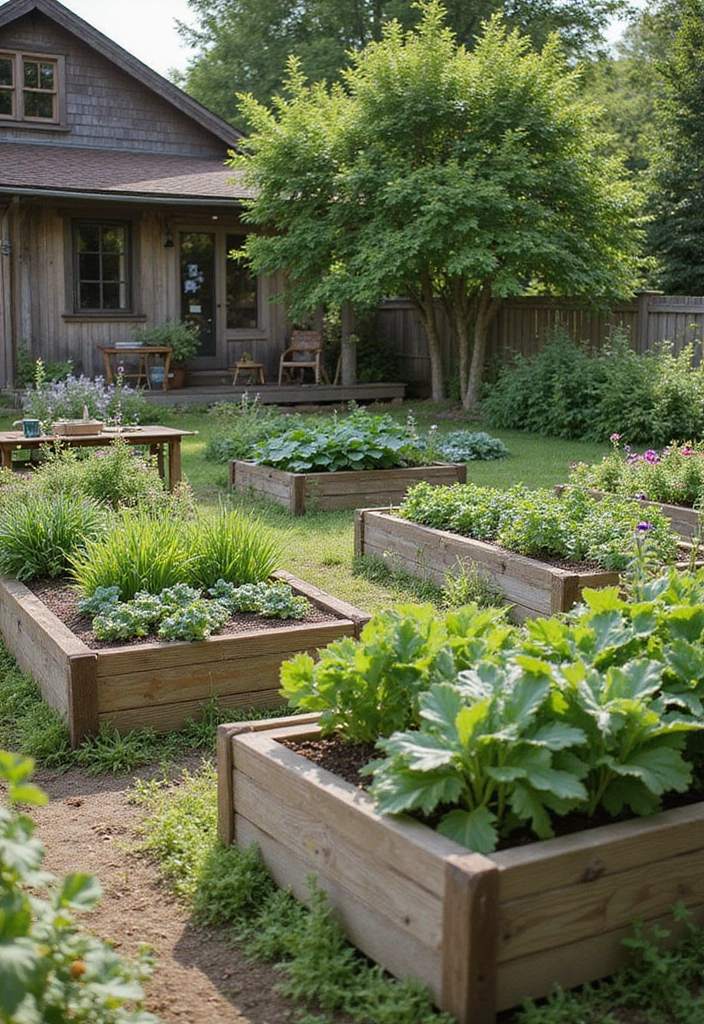
The rustic farmhouse style vegetable garden embraces a charm that combines practicality with aesthetics. This design often features wooden elements, natural materials, and a cozy, warm atmosphere.
Elements to Include:
– Raised beds or wooden planters made from reclaimed wood.
– Decorative garden signage and cozy seating areas.
– Wildflower borders to enhance the natural feel.
To achieve this rustic look, consider using repurposed materials like old pallets for raised beds or decorative fences. A great option for elevated planting is the raised garden bed kit, which offers a sturdy and stylish way to grow your vegetables. Mixing herbs, vegetables, and flowers can create a diverse and attractive space that echoes the charm of farmhouse living.
Enhance your garden’s aesthetic with whimsical touches, such as vintage tools or decorative fences. For instance, incorporating a decorative garden sign can add personality and guide visitors around your cozy retreat. A classic touch is also found in the vintage garden tools set, which not only helps with digging, weeding, and planting but also complements the rustic vibe of your garden.
The goal is to create a space that feels inviting, making it a perfect spot for both gardening and relaxation.
22. Interactive Edible Landscapes

Transforming your garden into an interactive edible landscape can engage families and children, making gardening fun! This concept emphasizes hands-on activities, learning, and enjoyment of fresh food.
Features:
– Designated areas for kids to plant and harvest.
– Attractive elements like edible flowers and fruit trees.
– Engaging pathways and structures for exploration.
Create a family-friendly space where children can learn about gardening by planting their own plot or harvesting fruits and veggies. Use colorful signs, like the garden pathway markers, to label various plants and whimsical paths that guide through the garden. These waterproof plastic garden labels, paired with a permanent marking pen, are perfect for keeping track of all your edible plants.
Incorporate edible flowers like nasturtiums that can be eaten and enjoyed, which you can easily grow from the edible flower seed pack. This collection includes a variety of flowers such as violas and calendulas, enhancing the beauty of your garden while providing delicious additions to meals.
Encourage creativity by allowing kids to decorate their planting areas or help with garden maintenance. A great way to get them involved is by providing them with a garden tool set for kids, which includes everything from a spade to a watering can. This hands-on approach not only makes gardening enjoyable but also builds lasting connections to nature and healthy eating.
23. Temperate Climate Gardening
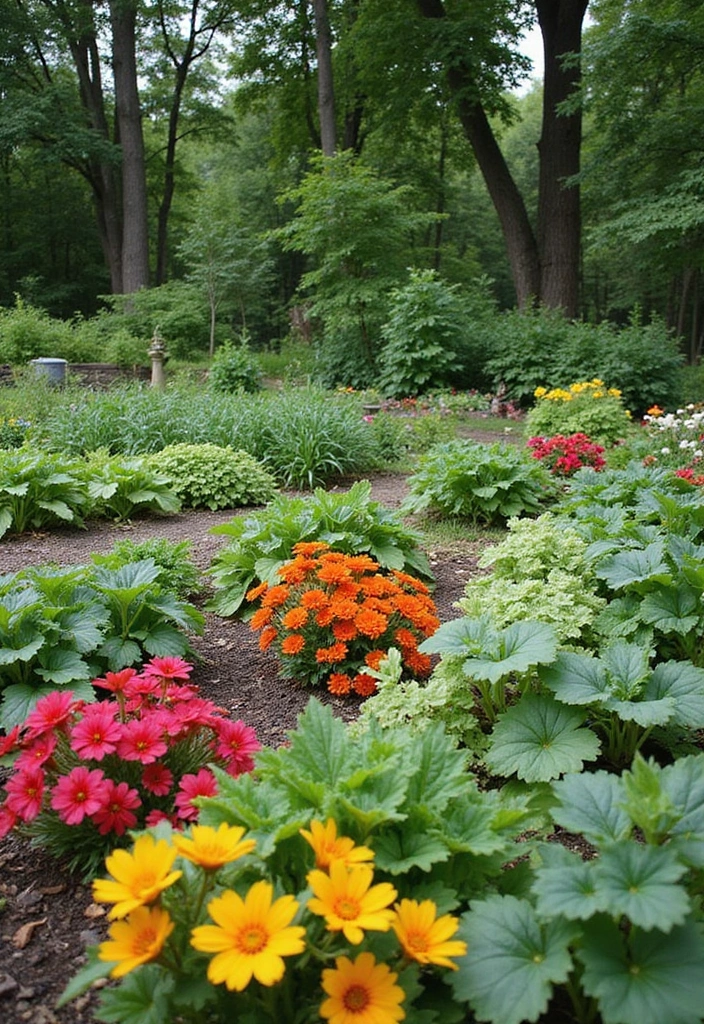
Gardening in temperate climates can offer a wide range of possibilities for diverse vegetable growing. This design approach focuses on seasonal changes and adapting planting strategies to optimize growth.
Benefits:
– Wide variety of vegetables and fruits that thrive in changing seasons.
– Ability to plant year-round with careful planning.
– Opportunities to explore diverse gardening styles.
To plan your garden layout effectively, it’s essential to understand your region’s climate. Group vegetables according to their seasonal tolerance, incorporating cold crops early in the spring, followed by warm-season plants in late spring and summer. For added protection during the cooler months, consider using garden row covers, which help plants, vegetables, fruits, and flowers grow better by shielding them from harsh weather.
Incorporating planting schedules that align with seasonal changes is crucial to keeping your garden productive all year. A helpful tool for this is a garden planner software, which allows you to repeat successes, learn from mistakes, and manage your garden layout effectively. With personal diaries for tracking suppliers and purchasing info, you can maintain a well-organized approach to your gardening efforts.
Additionally, understanding your soil is key to nurturing healthy plants. Using a soil test kit will allow you to quickly and accurately measure soil pH and nutrient levels, informing you about what amendments may be necessary to optimize growth conditions.
This thoughtful approach, combined with the right tools, fosters a healthy and vibrant vegetable garden.
24. Bountiful Harvest Festivals

Celebrating the harvest is a wonderful way to honor your gardening efforts! Harvest festivals can bring communities together to share the joy of fresh produce and the experiences of gardening.
Why Celebrate:
– Fosters community spirit and engagement.
– Promotes awareness about local farming and gardening.
– Creates a fun atmosphere for sharing produce and recipes.
Organize a community harvest festival where gardeners can showcase their produce, share recipes, and offer gardening workshops. To help plan your event, consider using the garden festival planning guide. This resource provides valuable insights into organizing a successful celebration.
Seasonal activities like pumpkin carving or corn mazes can engage families and children. To create engaging workshops, you might want to invest in some gardening workshop supplies like a set of durable gardening tools. These tools can help participants learn effective gardening techniques while also being useful for their own gardens.
Encourage participants to bring dishes made from their harvests, allowing everyone to enjoy the fruits of their labor together. To enhance the festive atmosphere, decorate your space with a harvest festival decorations kit. This will set a cheerful tone for the event and make it memorable.
These celebrations can create lasting memories and strengthen community ties. Sharing stories and tips can foster a supportive gardening network that extends beyond the festival.
25. Aesthetic Garden Borders
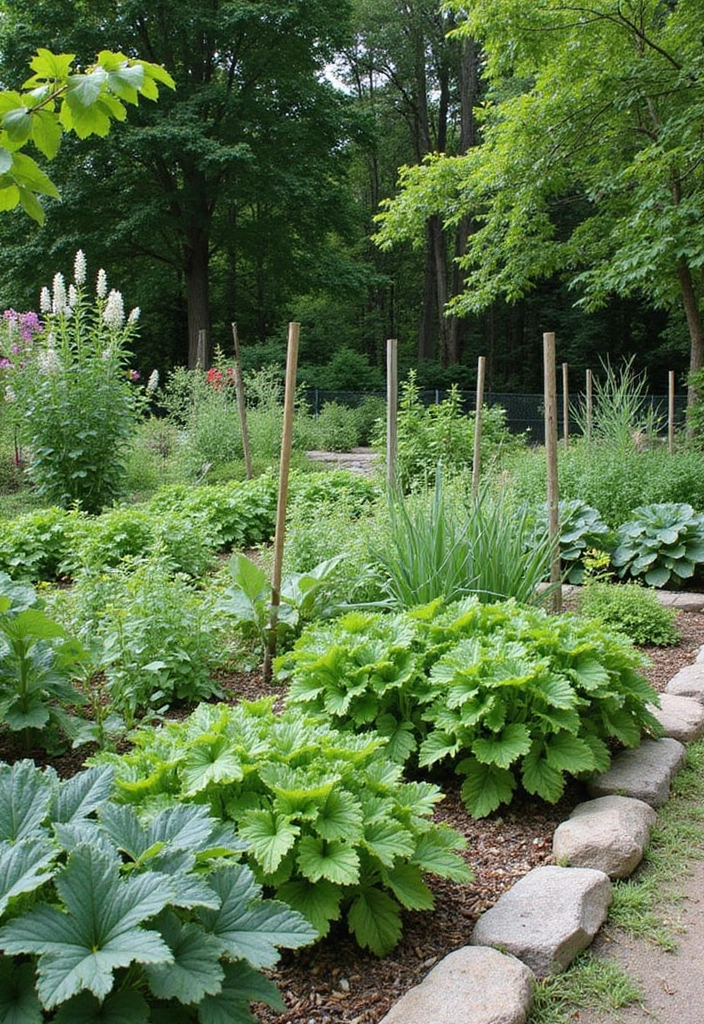
Aesthetic garden borders can enhance the beauty of your vegetable garden while providing functional benefits. Borders help define spaces, create visual interest, and even support plant health.
Benefits:
– Adds structure and organization to the garden layout.
– Acts as barriers against weeds and pests.
– Provides a decorative element to enhance the overall design.
Consider using natural materials to create borders around your garden beds, such as the Natural Stone Garden Border Edging, which offers a stylish slate gray finish that mimics stone without the need for digging. This no-dig solution not only looks great but also helps keep weeds at bay while maintaining a neat appearance.
If you prefer a more rustic touch, the Wooden Garden Border Fencing provides a charming decorative option. These small picket panels are perfect for creating a distinct barrier around your vegetable beds, ensuring that your plants are sheltered from pests while adding an inviting element to your garden.
For those looking to add a splash of color and attract pollinators, why not consider planting some Flowering Plant Border Seeds? The Pink English Daisy not only serves as a beautiful living border but also enhances the biodiversity of your garden, supporting a healthy ecosystem for your vegetables.
This thoughtful design not only creates visual appeal but also helps nurture your plants’ health and growth. Aesthetic garden borders don’t just beautify your veggie garden; they create a sanctuary for your plants while elevating your harvest game.
26. Intimate Garden Nooks
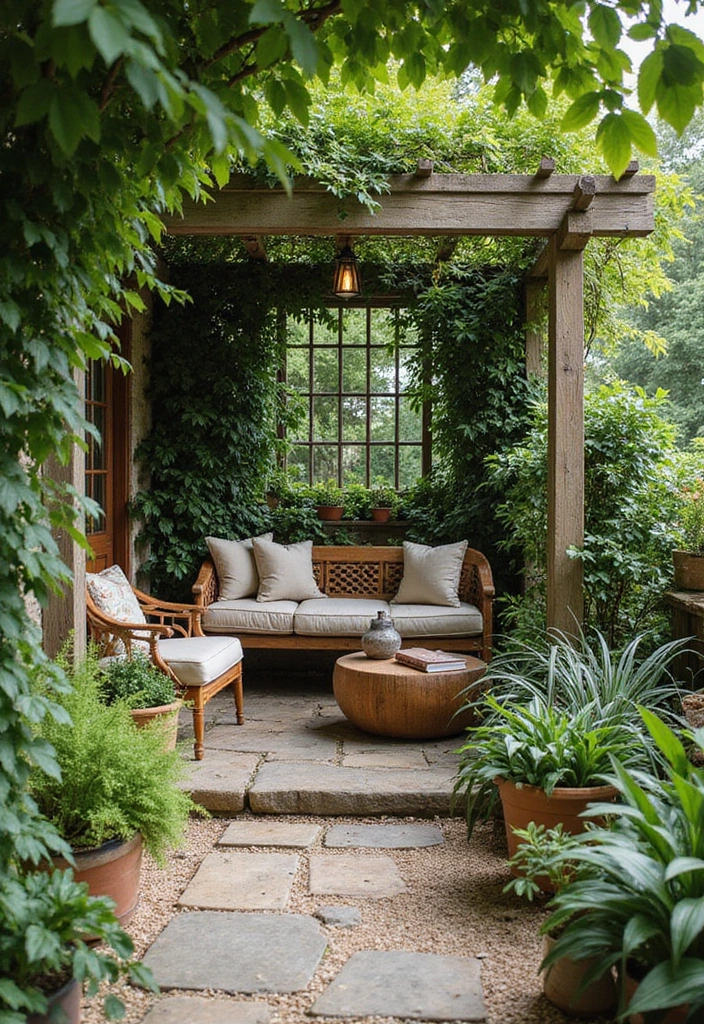
Creating intimate garden nooks can transform your vegetable garden into a peaceful retreat. These cozy corners offer a space for relaxation and enjoyment of nature while gardening or simply unwinding.
Features:
– Cozy seating areas integrated within the garden.
– Decorative elements like trellises or arbors.
– Surrounded by lush greenery and fragrant plants.
Designate a corner of the garden with comfortable seating, such as an outdoor garden bench, nestled among plants or trees. This weatherproof, heavy-duty bench provides a perfect spot to sit back and enjoy the fruits of your labor. Incorporate pathways leading to these nooks, making them accessible yet private. You can also enhance the visual appeal and support climbing plants by adding a decorative trellis. This versatile structure not only beautifies the space but can also create a lovely backdrop for your cozy corner.
To further enrich the atmosphere, consider including a small water feature like a small water fountain. This calming sound of flowing water can serve as a tranquil backdrop, fostering a sense of peace and mindfulness.
Creating these intimate spaces encourages appreciation for the effort you put into your vegetable garden, making it a favorite spot for quiet reflection amidst the hustle and bustle of daily life.
27. Creative Garden Labels
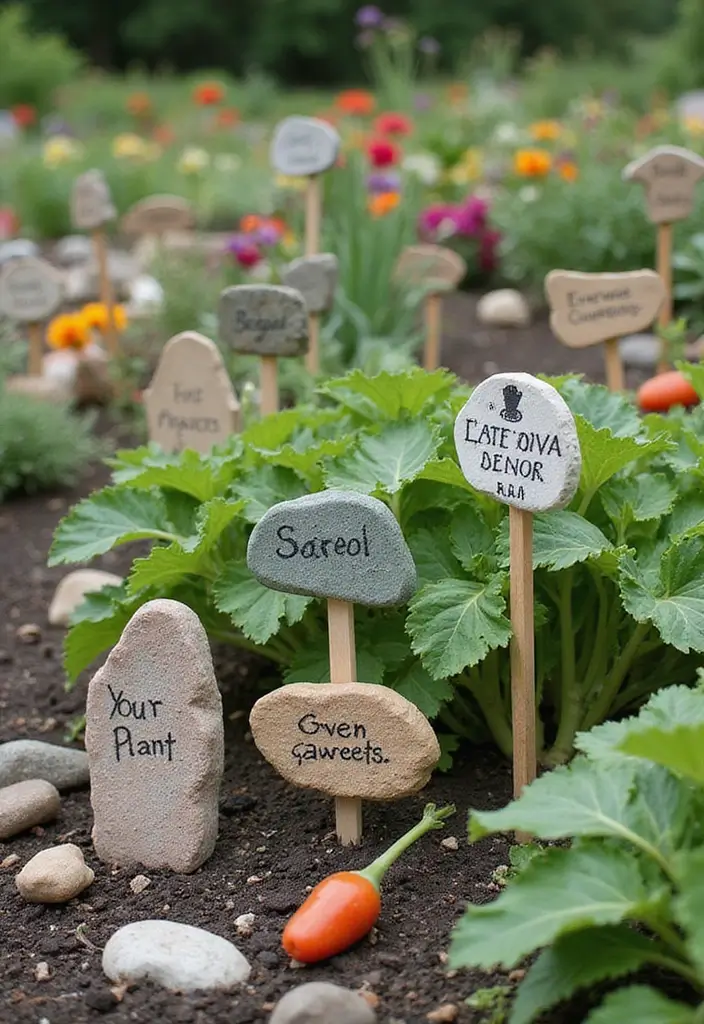
Creative garden labels add a fun and personalized touch to your vegetable garden while helping you keep track of your plants. These labels can enhance the overall design while offering practical benefits.
Why Use Labels:
– Helps with organization and plant identification.
– Adds a touch of personality and creativity to the garden.
– Engages family members in gardening activities.
For an easy and stylish way to label your plants, consider using Chalkboard Garden Labels. These wooden stakes allow you to write and rewrite your plant names, making them perfect for seasonal changes or experimenting with new varieties.
If you prefer a more traditional approach, the Wooden Plant Markers by Mr. Pen come in a handy pack of 100, providing plenty of room to label your entire garden while adding a rustic charm.
For those looking for a complete labeling solution, the DIY Garden Label Kit is a fantastic option. This kit includes waterproof plant tags and a pen, making it easy to identify seedlings, flowers, and vegetables, ensuring everything in your garden is neatly organized.
Get creative by painting or decorating your labels with designs that reflect your personality. Involving family members in creating these labels can also be a fun project. It’s a simple yet enjoyable way to personalize your space, making it uniquely yours while enhancing the overall garden aesthetic.
28. Seasonal Decor
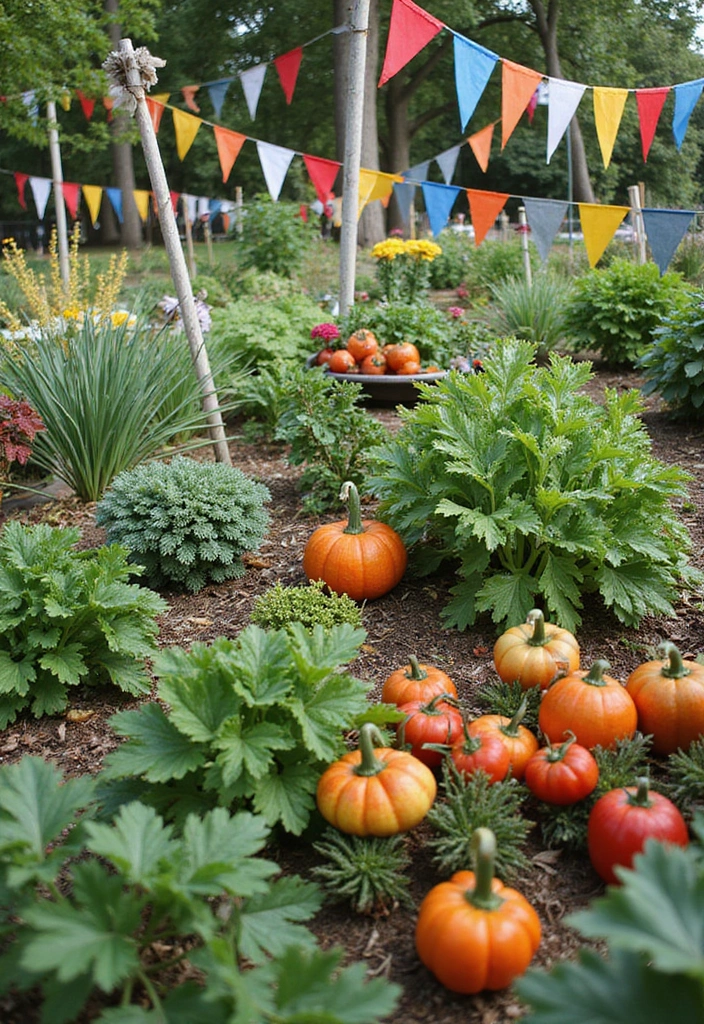
Incorporating seasonal decor into your vegetable garden adds a festive touch and keeps the garden visually appealing all year round. Changing decor with the seasons can make gardening feel more lively and vibrant.
Benefits:
– Enhances the overall garden atmosphere.
– Keeps the gardening experience fresh and engaging.
– Supports a sense of celebration for each season’s harvest.
Consider adding decorative items like a lovely seasonal garden wreath, which can welcome guests and create a cheerful entrance to your garden. During fall, pumpkins and hay bales can add charm, while a bright colorful garden flag can bring a pop of color to your outdoor space in the spring.
For a more whimsical touch, consider themed decor like the themed garden ornaments that can celebrate your love for gardening. These can be great conversation starters and add a personal touch to your garden.
Involve family and friends in creating or choosing seasonal decor, fostering a sense of community around your gardening efforts. This thoughtful approach adds joy and whimsy to your vegetable garden.
29. Gardening for Wellness
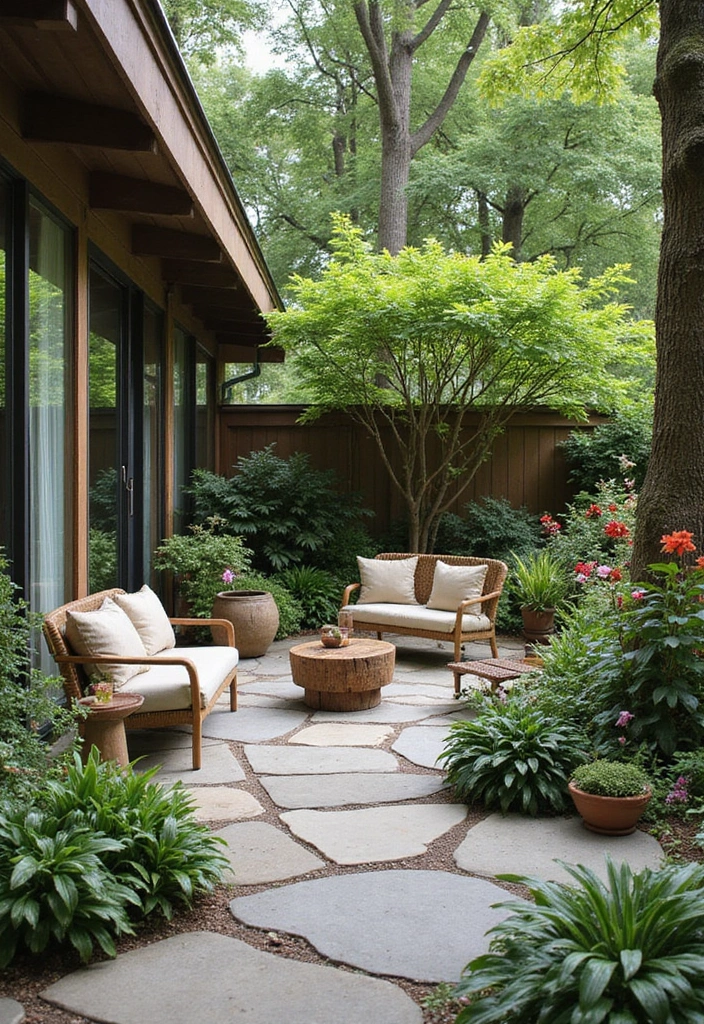
Gardening for wellness emphasizes the mental and physical benefits of gardening, creating a healing space that promotes well-being. This approach focuses on self-care, mindfulness, and the joy of growing your food.
Benefits:
– Reduces stress and promotes relaxation.
– Encourages physical activity and healthy eating.
– Fosters a connection to nature and community.
To enhance your gardening experience, consider incorporating practical tools like the Garden Kneeler and Seat. This multifunctional bench allows you to comfortably kneel while tending to your plants, reducing strain on your knees and back. Having a dedicated place to sit can also serve as a wonderful spot for relaxation and reflection among your greenery.
Design your garden layout to include areas for relaxation and mindfulness, such as a meditation corner among plants or a seating area with a view of your hard work. The Raised Garden Bed Kit is perfect for creating an organized and accessible garden space for easy harvesting of vegetables while keeping everything neat. Elevated beds reduce the need to bend over, making gardening more enjoyable and less physically taxing.
Consider planting easy-to-grow vegetables and flowers that bring joy and satisfaction. Adding sensory plants, like those found in the Sensory Plant Collection, can enhance your garden’s appeal. These interactive plants close their leaves when touched and reopen in minutes, adding an element of fun and engagement to your gardening routine.
Gardening for wellness not only nurtures your body but also enriches your mind, making it a vital part of living a balanced life.
Conclusion
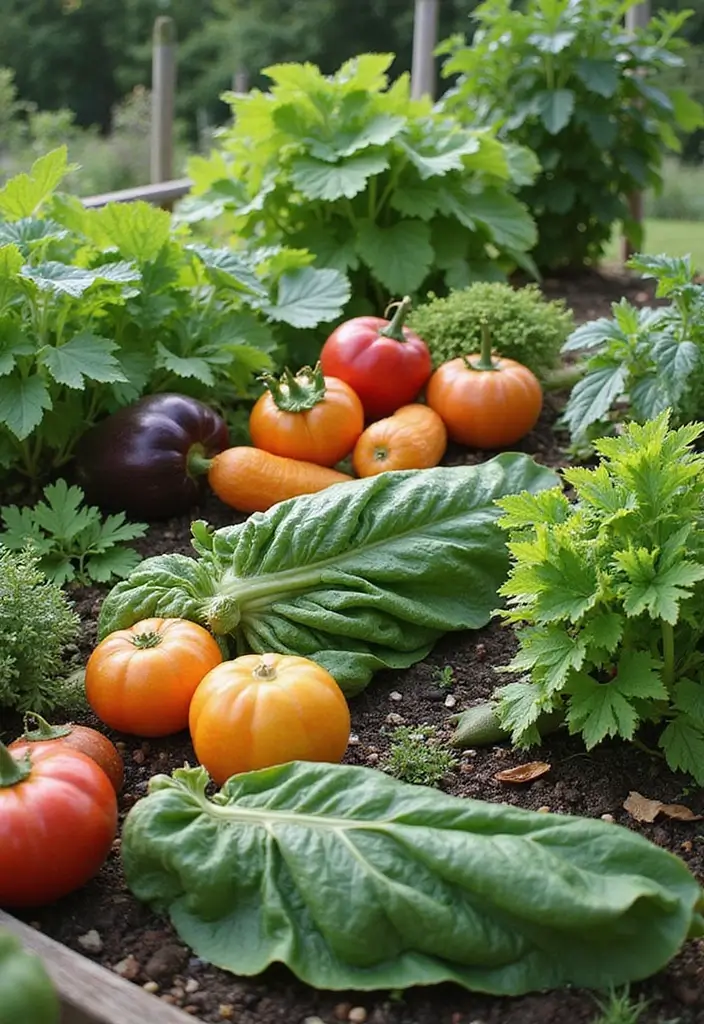
Designing a vegetable garden is an artistic journey, blending aesthetics, functionality, and sustainability. Each design idea offers unique benefits, ensuring that your garden flourishes and yields a bountiful harvest.
Explore different styles, and don’t hesitate to mix and match the ideas that resonate with you. The joy of growing your food and creating a beautiful space can be incredibly rewarding. Let your creativity shine as you plan your garden; after all, it’s a reflection of you and your love for nature.
Note: We aim to provide accurate product links, but some may occasionally expire or become unavailable. If this happens, please search directly on Amazon for the product or a suitable alternative.
This post contains Amazon affiliate links, meaning I may earn a small commission if you purchase through my links, at no extra cost to you.
Frequently Asked Questions
What are some key design ideas for a successful vegetable garden?
Creating a successful vegetable garden involves innovative design ideas that enhance both aesthetics and productivity. You might consider raised bed gardening for better soil control and accessibility, or try vertical gardening to maximize limited space. An herb spiral garden not only looks beautiful but also provides microclimates for various herbs, while container gardening offers flexibility for small areas like balconies or patios.
How can I plan a seasonal planting schedule for my vegetable garden?
A seasonal planting schedule is essential for ensuring a bountiful harvest throughout the year. Begin by researching your local climate and identifying the best times to plant various vegetables. Create a calendar noting when to sow seeds and transplant seedlings, taking into account factors like frost dates and growing seasons. This way, you can enjoy a staggered harvest and make the most of your veggie garden ideas!
What are some gardening tips for enhancing soil health?
Healthy soil is the foundation of a thriving vegetable garden! To enhance soil health, consider incorporating organic matter like compost or well-rotted manure. Regularly practice crop rotation to prevent nutrient depletion and pest buildup. Adding cover crops during off-seasons can also improve soil structure and fertility. By following these gardening tips, you’ll create a robust environment for your vegetables to flourish.
How can I attract pollinators to my vegetable garden?
Attracting pollinators is crucial for a productive veggie garden! Consider planting a variety of native flowers alongside your vegetables to create a diverse ecosystem. Incorporate pollinator-friendly plants like lavender, sunflowers, and bee balm, which provide nectar and habitat. Avoid using pesticides, as these can harm beneficial insects. By creating a welcoming environment, you’ll enhance pollination and improve your garden’s overall yield.
What is companion planting, and how can it benefit my vegetable garden?
Companion planting is a fantastic gardening technique that involves growing different plants together for mutual benefits. For example, planting basil alongside tomatoes can enhance growth and flavor while deterring pests. This approach can lead to healthier plants and increased yields in your vegetable garden. Experiment with various combinations to discover what works best in your space and enjoy the added benefits of this natural gardening strategy.
Related Topics

